Week 1: August 1-7, 2009
|
|
|
MBO gratefully acknowledges the financial support provided for the 2009 Fall Migration Monitoring Program by TD Friends of the Environment Foundation |
| THIS WEEK | THIS FALL | 2009 TOTAL | SITE TOTAL | |
|---|---|---|---|---|
| # birds (and species) banded | 228 (39) | 228 (39) | 1232 (72) | 20153 (105) |
| # birds (and species) repeat | 29 (12) | 29 (12) | 308 (35) | 3655 (66) |
| # birds (and species) return | 6 (5) | 6 (5) | 124 (29) | 578 (35) |
| # species observed | 71 | 71 | 148 | 198 |
| # net hours | 499.7 | 499.7 | 3858.2 | 34323.5 |
| # birds banded / 100 net hours | 45.6 | 45.6 | 31.8 | 58.7 |
Note: table does not include nocturnal banding (owls)
Banders-in-charge: Simon Duval, Marcel Gahbauer, Gay Gruner
Assistants: Christine Barrie, Mike Beaupré, Gilles Burelle, Sophie Cauchon, Jean Demers, Lance Laviolette, Francine Marcoux, Chris Murphy, André Pelletier, Clémence Soulard, Rodger Titman
Notes: MBO’s fifth full fall season began normally: with a bunch of birds! This week has been nicely busy despite some bad weather, beating last year’s weekly total of 187 birds banded and actually setting a new record for the first week of the fall. Species banded for the first time in 2009 included Downy Woodpecker, Wood Thrush and Scarlet Tanager. In addition, we had some returning visitors new for the site: a Tennessee Warbler that we first banded at this time last year! In the east this is one of the few species that appears to undertake a ‘moult migration’, i.e. moving some distance south from their breeding grounds to a stopover location where they complete their annual moult. So it would appear that at least one Tennessee Warbler has decided to make its visit to MBO an annual event.
|
Sparrow ID: In sequence, the three sparrows are Song, Swamp, and White-throated. All three species can show considerable variation, making identification quite difficult in some cases. Typically Song Sparrow has the boldest head markings (including a distinct malar stripe), Swamp Sparrow is distinctly rustier on the wings, back, and tail, and is also smaller, and White-throated Sparrow tends to be noticeably larger and may already have a trace of yellow in the lores, though as our quiz bird above shows, this isn’t always present. We’re just lucky we don’t also have Lincoln’s, Savannah, or Vesper Sparrows breeding nearby to compound the challenge! |
The first week of fall always involves a lot of birds breeding at MBO or nearby, but it’s worth starting this early because every year we do get the first migrants from further north trickling through. More often than not, we tend to have some unexpected visitors. This year the most notable find was a female Swainson’s Thrush still showing a brood patch and replacing her flight feathers. We don’t know of them breeding in the area, so are curious from how far she came to complete her moult at MBO.
This week’s top ten lists are quite representative of what’s on-site at the moment: our breeders (well, more or less)! The invasion of Common Grackles, which doesn’t always manifest itself, may be coming – only time will tell, but they were far more numerous this week than any other species, and jumped several ranks from last year at this time. House Wrens seem particularly abundant this year, and that’s reflected by them showing up in the lower half of this week’s top ten, and they may well remain there for a few weeks until they start dispersing or numbers of other species increase enough to push them down and off the list. Of note, last year American Crows were in 4th place, but so far this season they’ve been rather scarce, with only a few seen each day – we have no doubt that their numbers will grow over the course of the season though.
Among the birds banded, the top three are quite similar to last year, with Rose-breasted Grosbeak continuing a surprisingly strong first week presence (the surprise being that they’re rarely encountered at MBO in summer, so must be coming in from nearby). American Redstart, which last year topped our list of birds banded in mid-August, appears to be on the move in good numbers a bit earlier this year. Meanwhile House Wren, Cedar Waxwing, and American Robin jumped on the list this year, based on larger numbers breeding or otherwise hanging around the site than in 2008. Perhaps the biggest surprise though is the scarcity of Baltimore Orioles to date. They are traditionally among our most abundant captures early in fall (e.g. 3rd place in week 1 in each of the last three years, but outside the top ten this year).
| # individuals banded | mean # individuals observed daily |
|---|---|
| Yellow Warbler (25) [1] | 1. Common Grackle (42.1) [7] |
| 1.Song Sparrow (25) [2] | 2. Black-capped Chickadee (13.7) [6] |
| 3.Rose-breasted Grosbeak (16) [4] | 2. American Robin (13.7) [2] |
| American Redstart (15) [-] | Cedar Waxwing (13.3) [7] |
| 5. House Wren (13) [-] | 5. Song Sparrow (12.4) [4] |
| 6. Cedar Waxwing (12) [-] | 6. American Goldfinch (11.6)[1] |
| 7. American Robin (11) [-] | 7. House Wren (8.3) [-] |
| 7. White-throated Sparrow (11) [9] | 8. Yellow Warbler (7.3) [-] |
| 9. Red-eyed Vireo (10)[-] | 9. Red-winged Blackbird (6.1) [3] |
| 9. Gray Catbird (10) [5] | 10. Gray Catbird (5.9) [9] |
With the temporary return of Marcel Gahbauer and a full line-up of Banders-in-Charge, this fall promises to be one of MBO’s best: we’re coming up on our five-year anniversary (of full coverage) and are planning a summary report to examine the data we’ve collected so far. We’ve got some sneaking suspicions that we’ll be able to see some trends, even this early on. We are so thankful to our wonderful volunteers that brave weather, bugs, and early mornings to come and share our workload and to learn.
Last but not least, a very special thanks to Paul, Macdonald campus farm manager, for mowing our paths and making the trails manageable, and to our wonderful workhorse Malcolm, who showed the MBO jungle who was boss. We know they’re not the most glamorous jobs in the world, but they are one of the most important!
|
|
Week 2: August 8-14, 2009
|
|
|
|
MBO gratefully acknowledges the financial support provided for the 2009 Fall Migration Monitoring Program by TD Friends of the Environment Foundation |
| THIS WEEK | THIS FALL | 2009 TOTAL | SITE TOTAL | |
|---|---|---|---|---|
| # birds (and species) banded | 148 (33) | 376 (47) | 1380 (73) | 20301 (105) |
| # birds (and species) repeat | 35 (16) | 64 (19) | 343 (38) | 3690 (66) |
| # birds (and species) return | 3 (3) | 9 (7) | 127 (29) | 581 (35) |
| # species observed | 73 | 86 | 151 | 198 |
| # net hours | 466 | 965.7 | 4324.2 | 34789.5 |
| # birds banded / 100 net hours | 31.8 | 38.9 | 31.8 | 58.3 |
Note: table does not include nocturnal banding (owls)
Banders-in-charge: Simon Duval, Marcel Gahbauer, Gay Gruner
Assistants: Christine Barrie, Anna De Aguayo, Jean Demers, Barbara Frei, Tiffany Gilchrist, Barbara MacDuff, Francine Marcoux, Clémence Soulard, Rodger Titman
Notes: This week was a lot quieter at MBO, as is sometimes the case for the second week of August. Nevertheless, we still had some great sightings. Species observed for the first time this fall include Canada Goose, Osprey, Red-tailed Hawk, Red-shouldered Hawk, Northern Goshawk (new for the year as well), Merlin, Chimney Swift, Traill’s Flycatcher, Olive-sided Flycatcher (new for the year as well), Common Raven, Brown Creeper, Marsh Wren (new for the year as well), Northern Waterthrush, Rusty Blackbird, and Purple Finch. Species banded for the first time this season include Hairy Woodpecker, Traill’s Flycatcher (including a distinct Willow Flycatcher), Red-breasted Nuthatch (new for the year as well), Brown Creeper, Yellow-rumped Warbler, Chestnut-sided Warbler, Northern Waterthrush, and Purple Finch.
|
|
Among the list of species presented above, the Brown Creeper and Yellow-rumped Warbler really stand out, since typically we don’t start seeing them until late August until the earliest, and their peak movement is in late September and early October. But as the photos below show, this week’s birds were very young, so rather than being migrants from northern breeding grounds like most of the individuals we see of these two species, they must have come from a nest quite near MBO.
|
|
For the second week in a row, the species we banded most frequently were Song Sparrow and Yellow Warbler, bringing their respective totals for the season to 58 and 43 already. We tend to get Song Sparrows throughout the fall season, so that number will continue to grow substantially, but Yellow Warblers are a very early migrant and will likely become scarce within the next week or two. Even so, their total over the first two weeks already matches the highest previous fall total (recorded in both 2006 and 2007). Meanwhile, White-throated Sparrows are also off to an unusually strong start to the season, with 20 banded over the first two weeks, all but a couple of them juveniles. With the exception of Traill’s Flycatcher and Chestnut-sided Warbler arriving in small numbers, the dominant species at the nets were mostly similar to week one, a reflection of the very stagnant air mass that has been hanging around Montreal since late in week one.
Similarly, eight of the ten most frequently observed species this week were also on the list last week, the only differences being the addition of American Crows and Canada Goose (beginning to fly over the site more regularly), and the removal of Yellow Warbler and Red-winged Blackbird (which have continued to move out of the area). Common Grackles remained at the top of the list for a second straight week, largely on the basis of fairly sizeable flocks on a couple of days. In contrast, the Black-capped Chickadees and American Goldfinches are mostly local residents at this point, with relatively similar numbers seen daily.
| # individuals banded | mean # individuals observed daily |
|---|---|
| 1. Song Sparrow (32) [1] | 1. Common Grackle (18.1) [1] |
| 2. Yellow Warbler (18) [1] | 2. American Crow (17.0) [-] |
| 3.White-throated Sparrow (11) [7] | 3. Black-capped Chickadee (15.9) [2] |
| 3. Gray Catbird (11) [9] | American Goldfinch (13.4) [6] |
| 5. American Redstart (10) [4] | 5. Song Sparrow (12.7) [5] |
| 6. Traill’s Flycatcher (7) [-] | 6. Cedar Waxwing (11.0)[4] |
| 7. Common Yellowthroat (5) [-] | 7. Canada Goose (8.9) [-] |
| 7. Rose-breasted Grosbeak (5) [3] | 8. American Robin (8.6) [3] |
| 9. House Wren (4) [5] | 9. Gray Catbird (8.4) [10] |
| 9. Red-eyed Vireo (4)[9] 9. Chestnut-sided Warbler (4) [-] |
9. House Wren (8.4) [7] |
We’ve endured a very hot and humid week and on the whole are pleasantly surprised with the variety of species we observed and banded despite the distinctly non-fall-like weather. All the same, we’re looking forward to at least slightly cooler weather in week three, and perhaps a nice wave of warblers to come along with it and shake up our on-site numbers a bit more for the next report…
|
|
Week 3: August 15-21, 2009
|
|
|
|
MBO gratefully acknowledges the financial support provided for the 2009 Fall Migration Monitoring Program by TD Friends of the Environment Foundation |
| THIS WEEK | THIS FALL | 2009 TOTAL | SITE TOTAL | |
|---|---|---|---|---|
| # birds (and species) banded | 184 (33) | 560 (50) | 1564 (75) | 20485 (105) |
| # birds (and species) repeat | 38 (16) | 102 (23) | 381 (40) | 3728 (66) |
| # birds (and species) return | 3 (3) | 12 (10) | 130 (29) | 584 (35) |
| # species observed | 83 | 99 | 152 | 198 |
| # net hours | 544.0 | 1509.7 | 4868.2 | 35333.5 |
| # birds banded / 100 net hours | 33.8 | 37.1 | 32.0 | 57.9 |
Note: table does not include nocturnal banding (owls)
Banders-in-charge: Simon Duval, Marcel Gahbauer, Gay Gruner
Assistants: Christine Barrie, Gilles Burelle, Sophie Cauchon, Jean Demers, Barbara Frei, Tiffany Gilchrist, Marie-Anne Hudson, Helen Marchand, Francine Marcoux, Chris Murphy, André Pelletier, Clémence Soulard, Rodger Titman, Tegan Wahlgren, Roland Wahlgren
Notes: For those of us out at MBO this week, it seemed like a rather quiet week – and it was, with the number of birds banded only a bit higher than last week. But that’s not unusual – in fact, week 3 has traditionally been the quietest week of fall, probably since early migrants have started to move out, boreal migrants are still relatively few, and we’ve already banded most of the local young by now. Despite how it felt, this was actually the most productive week 3 we’ve ever had in terms of birds banded!
Of course it is early enough in the season that even a relatively quiet week generates a number of first-of-season records. Newly observed for fall 2009 were another 13 species, in order of appearance: Double-crested Cormorant, American Woodcock, Yellow-bellied Flycatcher, Northern Harrier, Pileated Woodpecker, Blue-headed Vireo, Golden-crowned Kinglet, Philadelphia Vireo, Orange-crowned Warbler, Turkey Vulture, American Kestrel, Common Merganser, and Bay-breasted Warbler. Three species were banded for the first time this fall, bringing our count to 50 species already: Eastern Wood-Pewee, Yellow-bellied Flycatcher, and Hermit Thrush. Of note, the Eastern Wood-Pewee was also the first of its kind observed or banded at MBO this year, and we also missed banding Yellow-bellied Flycatcher on their northbound flight in spring.
|
|
Song Sparrows maintained their position on top of the list of species banded for a third straight week. We keep thinking we must have banded all of them, then get back and find another half dozen or more in the nets the next day! Clearly, with 95 of them banded over the past three weeks, we’re no longer dealing with just local birds! The past two years, American Redstart has topped the list in week 3; this year they fell short thanks to the abundance of Song Sparrows, but still showed a big increase over week 2 as usual. After two weeks as runner-up to the Song Sparrow, Yellow Warbler has faded to near the bottom of the list, and will probably not reappear there until some time next May. Jumping in to a tie for third place this week were two other warblers – Common Yellowthroat and Black-and-white Warbler. The other addition to the list this week was American Goldfinch, including the first of this year’s young. The remaining species (Red-eyed Vireo, Gray Catbird, Traill’s Flycatcher, and Rose-breasted Grosbeak) shuffled positions a bit from last week.
With respect to birds observed, there was only one new additions to the top ten this week, with Red-winged Blackbird displacing Canada Goose. The Black-capped Chickadees are likely still mostly local residents, but they were vocal and active enough this week to slide up into the top spot ahead of Cedar Waxwing (erratic, with larger flocks on a couple of days) and American Goldfinches (still singing plenty as for them it’s still prime breeding season). Grackles dropped off a bit this week, but we’re sure larger flocks will be returning later this fall.
| # individuals banded | mean # individuals observed daily |
|---|---|
| 1. Song Sparrow (37) [1] | 1. Black-capped Chickadee (17.0) [3] |
| 2. American Redstart (20) [5] | 2. Cedar Waxwing (15.9) [6] |
| 3.Common Yellowthroat (10) [-] | 3. American Goldfinch (15.7) [4] |
| 3. Black-and-white Warbler (10) [-] | Red-winged Blackbird (12.4) [-] |
| 5. Red-eyed Vireo (9) [9] | 5. Song Sparrow (11.6) [5] |
| 5. Gray Catbird (9) [3] | 6. American Crow (11.3)[2] |
| 7. Traill’s Flycatcher (8) [6] | 7.American Robin (8.1) [8] |
| 8. American Goldfinch (7) [-] | 8. House Wren (7.6) [9] |
| 8. Yellow Warbler (7)[2] | 9. Common Grackle (6.6) [1] |
| 8.Rose-breasted Grosbeak (7) [7] | 10. Gray Catbird (6.3) [9] |
We owe a BIG thank you to Malcolm Johnson, who came in this week to mow all of our net lanes – the ongoing heat and moisture has made it a jungle out there, and we were in sore need of taming it. Meanwhile, all of the BICs have also been taking turns trying to regain some control over the vegetation, especially along the net lanes and census trail. We take habitat photos annually, so that we can try to maintain relatively consistent conditions over the years (in order to minimize confounding effects with any trends we document in our bird data). Of course maintaining complete stasis in a largely successional habitat is impossible, but by selectively trimming some shrubs and trees and removing others, we’re striving to achieve an overall balance. The same holds true for the census trail, where buckthorns and vines in particular have grown to obstruct some productive viewpoints – but there it’s also a matter of just keeping the trail itself in decent shape so that censusers can concentrate on looking for birds rather than finding their footing and avoiding branches in the eyes! We’ve made some good progress on that, and hope to get all this site maintenance done before migration kicks into a higher gear in September!
In the “critter corner” this week we feature three of the most cute / interesting / peculiar non-birds at MBO this week (you get to pick which descriptor applies to which, according to your personal preferences!).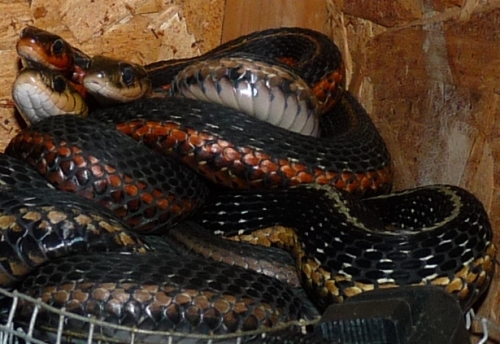 The shed attached to the banding cabin was long overdue for a good cleaning, and we took advantage of a couple of slower mornings this week to tackle it. Unfortunately, in doing so we disturbed this cozy trio of garter snakes, that had climbed up to coil together on top of a roll of wire. The good news is that while they slithered off in frustration at the commotion, they were all back the next day, enjoying our newly stacked pile of firewood. Note the distinctly different colouration of each of the three snakes. (Photo by Marcel Gahbauer)
The shed attached to the banding cabin was long overdue for a good cleaning, and we took advantage of a couple of slower mornings this week to tackle it. Unfortunately, in doing so we disturbed this cozy trio of garter snakes, that had climbed up to coil together on top of a roll of wire. The good news is that while they slithered off in frustration at the commotion, they were all back the next day, enjoying our newly stacked pile of firewood. Note the distinctly different colouration of each of the three snakes. (Photo by Marcel Gahbauer)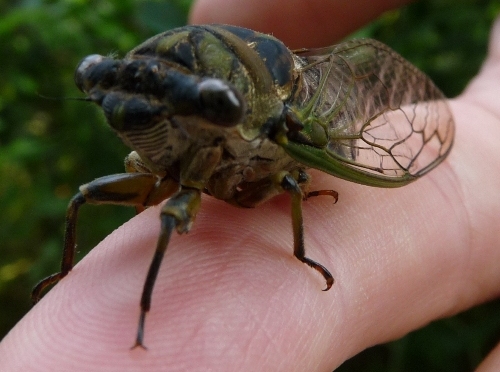 The persistent buzzing of cicadas is a common sound of summer in Montreal, as it is in many areas. However, while most are familiar with the sound, we’re willing to bet relatively few have ever handled a cicada. This week several of us had that opportunity, courtesy of them flying into our nets. Fortunately, aside from some annoyed buzzing, they were actually quite well-behaved, and they’re certainly quite a beast to look at up close. (Photo by Marcel Gahbauer)
The persistent buzzing of cicadas is a common sound of summer in Montreal, as it is in many areas. However, while most are familiar with the sound, we’re willing to bet relatively few have ever handled a cicada. This week several of us had that opportunity, courtesy of them flying into our nets. Fortunately, aside from some annoyed buzzing, they were actually quite well-behaved, and they’re certainly quite a beast to look at up close. (Photo by Marcel Gahbauer)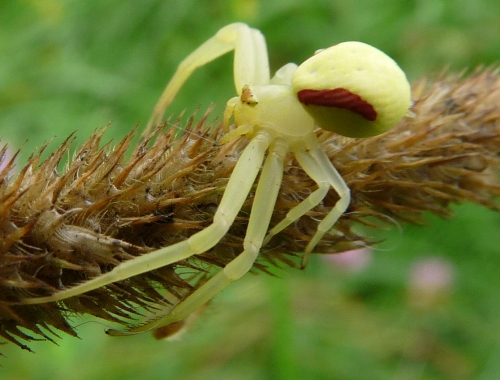 A colourful discovery on the last morning of the week, this small Goldenrod Crab Spider (Misumena vatia) was right along the path from the ‘parking circle’ to the banding cabin. Not only are the colours striking, but the body shape (dimples on the back barely visible from this angle, and the oversized front legs) is quite unusual. (Photo by Marcel Gahbauer)
A colourful discovery on the last morning of the week, this small Goldenrod Crab Spider (Misumena vatia) was right along the path from the ‘parking circle’ to the banding cabin. Not only are the colours striking, but the body shape (dimples on the back barely visible from this angle, and the oversized front legs) is quite unusual. (Photo by Marcel Gahbauer)
Week 4: August 22-28, 2009
|
|
|
|
MBO gratefully acknowledges the financial support provided for the 2009 Fall Migration Monitoring Program by TD Friends of the Environment Foundation |
| THIS WEEK | THIS FALL | 2009 TOTAL | SITE TOTAL | |
|---|---|---|---|---|
| # birds (and species) banded | 196 (33) | 756 (54) | 1760 (77) | 20681 (105) |
| # birds (and species) repeat | 40 (18) | 142 (25) | 421 (40) | 3768 (66) |
| # birds (and species) return | 2 (2) | 14 (11) | 132 (29) | 586 (35) |
| # species observed | 78 | 107 | 155 | 198 |
| # net hours | 533.0 | 2042.7 | 5401.2 | 35866.5 |
| # birds banded / 100 net hours | 36.8 | 37.0 | 32.5 | 57.6 |
Note: table does not include nocturnal banding (owls)
Banders-in-charge: Simon Duval, Marcel Gahbauer, Gay Gruner
Assistants: Isabelle Bisson, Marcelo Brongo, Jean Demers, Barbara Frei, Tiffany Gilchrist, Bana Hamze, Marie-Anne Hudson, Kristen Keyes, Barbara and Don MacDuff, Francine Marcoux, Chris Murphy, Clémence Soulard, Alex Stone, Rodger Titman
Notes: It’s hard to believe, but we’ve already completed nearly a month of fall migration monitoring. On the whole, numbers this week were rather similar to last week, and again they were fairly high compared to other years at the same time, most similar at this point to the very productive start to 2006. With a cold front moving through the region on Wednesday night, the final two days of the week did begin to show a bit of a change in the mix of migrants present.
We added another 8 species to our checklist of birds observed this fall, in chronological order: American Black Duck, Wilson’s Warbler, Broad-winged Hawk, Herring Gull, Black-throated Green Warbler, Great Horned Owl, Least Sandpiper, and Blackburnian Warbler. Most of these were chance sightings – American Black Ducks, Least Sandpipers and Herring Gull flying overhead, a single Wilson’s Warbler caught on Sunday morning, a single early morning series of hoots from a Great Horned Owl, and lone Broad-winged Hawk and Blackburnian Warbler courtesy of census. Out of these, the Black Duck, Great Horned Owl, and Least Sandpiper were observed for the first time this year. On the banding front, the Wilson’s Warbler was the first of the fall, along with Blue Jay, Black-throated Green Warbler, and Sharp-shinned Hawk; the latter two were banded for the first time in 2009.
|
|
Song Sparrows extended their dominance of the banding list to a fourth straight week – the first time we have had any species on top right throughout August. This week they had a commanding lead over American Redstart and Common Yellowthroat, which filled the two runner-up spots for a second week in a row. Beyond that, however, there were a lot of changes, with only two of the remaining eight species (we had a tie) carry-overs from last week: Black-and-white Warbler and Red-eyed Vireo. Top newcomers were Black-capped Chickadee (perhaps foreshadowing what we expect might be a busy fall for them) and Magnolia Warbler – which for the past four years had been the top species for week four. Others added to the list in a four-way tie for eighth place were Cedar Waxwing, Ovenbird, Tennessee Warbler, and Yellow-bellied Flycatcher.
There was less change in the list of species most frequently observed, with only American Redstart being added in a tie for ninth, in place of House Wren last week. Others shuffled around the list a bit, with American Crow making it to the top spot for the first time this fall, and last week’s top three each sliding down one place accordingly. Red-winged Blackbirds made the most noticeable drop down the list, and even so were retained only thanks to a large flock that roosted in Stoneycroft Pond one night this week and took off while the nets were being put up for the morning.
| # individuals banded | mean # individuals observed daily |
|---|---|
| 1. Song Sparrow (30) [1] | 1. American Crow (21.7) [6] |
| 2. American Redstart (18) [2] | 2. Black-capped Chickadee (19.7) [1] |
| 3.Common Yellowthroat (16) [3] | 3. Cedar Waxwing (19.6) [2] |
| 4. Red-eyed Vireo (14) [5] | American Goldfinch (16.3) [3] |
| 5. Black-capped Chickadee (11) [-] | 5. Song Sparrow (10.7) [5] |
| 5. Magnolia Warbler (11) [-] | 6. Gray Catbird (8.4)[10] |
| 7. Black-and-white Warbler (8) [3] | 7.American Robin (8.0) [7] |
| 7. Ovenbird (8)[-] | 8. Red-winged Blackbird (7.3) [4] |
| 9. Yellow-bellied Flycatcher (7) [-] | 9. American Redstart (6.9) [-] |
| 9. Cedar Waxwing (7) [-] | 9. Common Grackle (6.9) [9] |
With seasonal temperatures in the long-range forecast, we’re eager to see whether our traditional rich mix of warblers will move through MBO over the next couple of weeks…
|
|
Week 5: August 29 – September 4, 2009
|
|
|
|
MBO gratefully acknowledges the financial support provided for the 2009 Fall Migration Monitoring Program by TD Friends of the Environment Foundation |
| THIS WEEK | THIS FALL | 2009 TOTAL | SITE TOTAL | |
|---|---|---|---|---|
| # birds (and species) banded | 159 (34) | 915 (56) | 1919 (77) | 20840 (105) |
| # birds (and species) repeat | 37 (11) | 179 (25) | 458 (40) | 3805 (66) |
| # birds (and species) return | 7 (6) | 21 (15) | 139 (31) | 593 (37) |
| # species observed | 76 | 112 | 156 | 198 |
| # net hours | 476.3 | 2519.0 | 5877.5 | 36342.8 |
| # birds banded / 100 net hours | 33.4 | 36.3 | 32.5 | 57.3 |
Note: table does not include nocturnal banding (owls)
Banders-in-charge: Simon Duval, Marcel Gahbauer, Gay Gruner
Assistants: Christine Barrie, Sophie Cauchon, Jean Demers, Nicki Fleming, Barbara Frei, Tiffany Gilchrist, Barbara and Don MacDuff, Francine Marcoux, Chris Murphy, André Pelletier, Emilie Roy-Dufresne, Clémence Soulard, Alex Stone
Notes: The numbers for this week look decent, but that’s largely to a couple of very productive days that stood in stark contrast to the rest. With respect to birds banded, 47 on Monday and 40 on Friday were both among the five busiest days so far this season … but we lost Saturday to rain, and on the other days we had meager totals ranging from just 11 to 22. We had a similar week 5 lull in 2006 on the way to a very successful season, so hopefully this is just a temporary blip in activity. On the other hand, there have been various reports this year of an unusually poor (cold and wet) breeding season across much of northern Canada, so it’s possible that a variety of species may have had relatively unsuccessful breeding seasons that would be reflected in our fall numbers. We’ll have a better idea about that as the season progresses.
Despite the foregoing comments, we’re so far still in good position compared to previous years with respect to most of our totals. We’ve banded 56 species to date (previous range 53 to 59), with this week’s new additions being Bay-breasted and Blackpoll Warblers. Meanwhile, though the 76 species observed this week is a record low for week 5 (previously 79 to 88), they included four new species (Pied-billed Grebe, Peregrine Falcon, Northern Parula, and Blackpoll Warbler), bringing our season total to 111 (previous range 107 to 112).
|
|
After spending all of August atop our list of most frequently banded species, Song Sparrows have finally been deposed, with Magnolia Warblers taking over, largely on the strength of 16 individuals banded on Monday morning alone. Magnolia Warbler has topped the week 5 list in all previous fall seasons, so their abundance this week was no surprise. Meanwhile American Redstarts continue their strong showing this year, in second place for a third week in a row, and with a cumulative total to date of 88 individuals banded, already approaching the fall season record of 99 we set last year. Common Yellowthroat and Black-capped Chickadee slid a bit down the list this week, with Black-throated Blue Warbler jumping in at 4th place, and Yellow-bellied Flycatchers in decent numbers for a second straight week. Indigo Buntings made the list thanks to just two net rounds on Thursday morning!
| # individuals banded | mean # individuals observed daily |
|---|---|
| 1. Magnolia Warbler (31) [4] | 1. Canada Goose (24.3) [-] |
| 2. American Redstart (26) [2] | 2. Black-capped Chickadee (22.0) [2] |
| 3.Song Sparrow (10) [1] | 3. American Crow (17.7) [1] |
| Black-throated Blue Warbler (8) [-] | Cedar Waxwing (16.4) [3] |
| Common Yellowthroat (8) [3] | 5. American Goldfinch (12.1) [4] |
| 6. Black-capped Chickadee (6) [4] | 6. Common Grackle (11.9)[9] |
| 6. Yellow-bellied Flycatcher (6) [9] | 7. American Redstart (8.1) [9] |
| 8. Indigo Bunting (5) [-] | 8. Blue Jay (7.6) [-] |
| 8. Wilson’s Warbler (5)[-] | 9. Gray Catbird (7.4) [6] |
| 10. House Wren (4) [-] 10. Gray Catbird (4) [-] 10. Cedar Waxwing (4) [9] 10. Northern Waterthrush (4) [-] 10. Canada Warbler (4) [-] |
10. Magnolia Warbler (6.6) [-] |
Flocks of Canada Geese have started to pass by on some mornings, allowing them to jump right to the top of the list of most observed species. Last week’s top four shuffled slightly down as a result; of note, the chickadee count rose as high as 47 on Friday, and it’s quite apparent that the vast majority of them are migrants rather than our local residents. Early indications therefore suggest that the two-year cycle of Black-capped Chickadees is progressing as expected (though in other “odd” years we didn’t notice the influx distinctly until later in September). American Robin, Song Sparrow, and Red-winged Blackbird dropped off the list this week, replaced by the goose, Blue Jay, and Magnolia Warbler.
|
|
Week 6: September 5 – 11, 2009
|
|
|
|
MBO gratefully acknowledges the financial support provided for the 2009 Fall Migration Monitoring Program by TD Friends of the Environment Foundation |
| THIS WEEK | THIS FALL | 2009 TOTAL | SITE TOTAL | |
|---|---|---|---|---|
| # birds (and species) banded | 109 (33) | 1024 (59) | 2028 (79) | 20949 (105) |
| # birds (and species) repeat | 29 (11) | 208 (26) | 487 (41) | 3834 (66) |
| # birds (and species) return | 4 (4) | 25 (16) | 143 (32) | 597 (37) |
| # species observed | 75 | 116 | 158 | 198 |
| # net hours | 554.0 | 3073.0 | 6351.5 | 36896.8 |
| # birds banded / 100 net hours | 19.7 | 33.3 | 31.4 | 56.7 |
Note: table does not include nocturnal banding (owls)
Banders-in-charge: Simon Duval, Marcel Gahbauer, Gay GrunerAssistants: Christine Barrie, Jean Beaudreault, Isabelle-Anne Bisson, Jean Demers, Nicki Fleming, Barbara Frei, Chloe Gendre, Tiffany Gilchrist, Kristen Keyes, Meg Langley, Barbara MacDuff, Francine Marcoux, Chris Murphy, Clémence Soulard, Alex Stone, Carine Touma
Notes: At times this week it almost seemed like the birds had read last week’s report and were determined to show us what a REALLY slow fall week is like. Only on Friday did we finally band more than 15 birds in a day, and even then the total of 25 was rather slow for this time of year. For comparison, last year during this week we banded 343 birds, and in the previous three years our range had been from 162 to 279. Diversity was also quite low, with daily estimated totals often in the 35 to 40 species range, and the weekly total of 75 the fewest we’ve ever had at this time of year.
Why such a slow week? It’s hard to say, as various factors could be at play. As noted last week, a poor breeding season in much of the boreal forest could be at least partly to blame. However, it was also a rather warm week (temperatures a few degrees above the seasonal norm) with remarkably consistent conditions, so the lack of distinct weather fronts might have held back some birds longer than usual. Again, all we can do is wait and watch how the rest of the season unfolds.
Despite how quiet the week was compared to our expectations, we added some species to our seasonal and yearly totals as usual. A Black-billed Cuckoo detected while opening nets one morning was our first observed at MBO this year; other species seen for the first time this fall were Spotted Sandpiper, Ruby-crowned Kinglet, Western Palm Warbler, and Cape May Warbler. The Palm Warbler was our first to be banded this year, as was the Philadelphia Vireo featured lower down on this page. We also had our first Rose-breasted Grosbeak return of the year (i.e. a previously banded bird not recaptured for at least 3 months), a male we banded two years ago.
|
In contrast, the tail below is much grayer, and also the uppertail coverts are largely greenish with minimal black centre spots. Even on pale birds, there is usually at least some white on all of r2 to r6 (the outermost five rectrices on either side). In this case, the outermost feather on the right side is hidden from view, but what is evident is that there is no white at all on r2, and even r3 has just a small spot, so we can probably be quite certain this is a hatch-year female. (Photos by Marcel Gahbauer)
|
In the first two weeks of August we banded 20 White-throated Sparrows, almost all juveniles that must have come from nests rather nearby. Since then though, we’ve banded relatively few additional ones, so the sudden appearance of the species at the top of our list of species banded this week is a sure sign that the migrants from further north have started to arrive … and we expect them to remain among the most dominant species for the next few weeks. Magnolia Warbler and Song Sparrow remained near the top of the list this week; of note, we banded 109 Magnolia Warblers during this week last year, so that is a significant factor explaining this year’s lower total. American Redstart dropped to fourth place this week, marking the sixth week in a row that it has ranked at least that high, an impressive streak of consistency. They dropped off noticeably though as week 6 progressed, so it’s possible they will fall off the list next week as more northern species arrive in (hopefully) larger numbers. The “blue birds” (Indigo Bunting, Black-throated Blue Warbler, and Blue Jay) all had a good showing this week. Although remaining numerous, Black-capped Chickadees continued to largely elude the nets this week.
| # individuals banded | mean # individuals observed daily |
|---|---|
| 1. White-throated Sparrow (18) [-] | 1. Canada Goose (42.7) [1] |
| 2. Magnolia Warbler (10) [1] | 2. American Crow (31.0) [3] |
| 2. Song Sparrow (10) [1] | 3. Cedar Waxwing (25.4) [4] |
| American Redstart (7) [2] | Black-capped Chickadee (22.7) [2] |
| 5. Common Yellowthroat (6) [4] | 5. Common Grackle (21.0) [6] |
| 5. Indigo Bunting (6) [8] | 6. American Goldfinch (15.6)[5] |
| 7. Red-eyed Vireo (5) [-] | 7. Blue Jay (12.9) [8] |
| 7. Black-throated Blue Warbler (5) [4] | 8. American Robin (12.7) [-] |
| 9. Black-capped Chickadee (4)[6] | 9. White-throated Sparrow (10.1) [-] |
| 10. Blue Jay (3) [-] 10. Blackpoll Warbler (3) [-] 10. Northern Waterthrush (3) [10] 10. Ovenbird (3) [-] |
10. Song Sparrow (9.9) [-] |
The Canada Goose flocks continue to grow slowly, putting them on top of our list of most observed species for a second week in a row. The rest of the top seven is also awfully similar to last week, with only Common Grackle and American Goldfinch switching between fifth and sixth place, and Black-capped Chickadee being pushed down by increases in the number of American Crows and Cedar Waxwings. The bottom three spots are occupied by American Robin, White-throated Sparrow, and Song Sparrow, the first two of which are likely to increase substantially in prominence over the coming weeks.
Extra thanks this week to Ryan Young for organizing the annual Ecology Day in Ste-Anne-de-Bellevue and offering MBO a prominent booth there, as well as to Tiffany Gilchrist and Marcel Gahbauer for staffing the booth. If you’re reading this as a result of having stopped by to chat, we look forward to having you out at MBO as volunteers!
|
|
Week 7: September 12 – 18, 2009
|
|
|
|
MBO gratefully acknowledges the financial support provided for the 2009 Fall Migration Monitoring Program by TD Friends of the Environment Foundation |
| THIS WEEK | THIS FALL | 2009 TOTAL | SITE TOTAL | |
|---|---|---|---|---|
| # birds (and species) banded | 185 (38) | 1209 (64) | 2213 (81) | 21134 (105) |
| # birds (and species) repeat | 29 (10) | 237 (28) | 516 (42) | 3863 (66) |
| # birds (and species) return | 1 (1) | 26 (16) | 144 (32) | 598 (37) |
| # species observed | 71 | 120 | 159 | 198 |
| # net hours | 504.0 | 3577.0 | 6935.5 | 37400.8 |
| # birds banded / 100 net hours | 36.7 | 33.8 | 31.8 | 56.5 |
Note: table does not include nocturnal banding (owls)
Banders-in-charge: Simon Duval, Marcel Gahbauer, Gay GrunerAssistants: Josiane Alarie, Veronica Aponte, Christine Barrie, Jean Beaudreault, Catherine Doucet, Tiffany Gilchrist, Jeff Harrison, Marie-Anne Hudson, Kristen Keyes, Gabrielle Laurent, Francine Marcoux, Chris Murphy, Alex Stone, Rodger Titman, Carine Touma
Notes: The first day of this week started much like last week ended, with just a trickle of birds banded, and the last morning of the week was largely lost to rain and very gusty winds. In between, however, results were more encouraging than the past couple of weeks, with an average of 35 birds banded each morning. That’s still somewhat below average for this time of year, but the increasing number of sparrows as the week progressed bodes well for next week.
Among the birds we did catch this week were two species banded for the first time this year (Black-billed Cuckoo and Orange-crowned Warbler) plus another three banded for the first time this fall (Blue-headed Vireo, Ruby-crowned Kinglet, and Lincoln’s Sparrow). The Lincoln’s Sparrow was also one of four species observed for the first time this fall, the others being Snow Goose, Slate-colored Junco, and Clay-colored Sparrow. The latter was the highlight of Thursday morning’s census, and only the second record for MBO.
|
|
To our surprise, Song Sparrows have returned to the top of the list of species banded for the week, the fifth time they’ve occupied that position in this fall’s seven weeks to date! Previously we had never banded more than 23 Song Sparrows in week 7, so all signs point toward Song Sparrows being one of relatively few species that appear to have had an unusually productive breeding season this summer. White-throated Sparrows, typically the more abundant sparrow at this time of year, slipped down to second place; interestingly they were observed in much larger numbers than Song Sparrows this week, indicating that either they were less likely to find the nets, or (more probably) the Song Sparrows were quieter and undercounted due to being less conspicuous. Nashville Warblers have been remarkably scarce this fall, so their appearance in fourth place is a welcome surprise at this point. Indigo Buntings remain unusually common for this time of year, with more banded over the past three weeks than in some entire fall seasons. The remainder of the top ten is rounded out with small numbers of a variety of relatively common species.
| # individuals banded | mean # individuals observed daily |
|---|---|
| 1. Song Sparrow (34) [2] | 1. Canada Goose (80.6) [1] |
| 2. White-throated Sparrow (31) [1] | 2. European Starling (25.1) [-] |
| 3.Magnolia Warbler (12) [2] | 3. American Robin (24.7) [8] |
| Nashville Warbler (10) [-] | Cedar Waxwing (24.0) [3] |
| Indigo Bunting (10) [5] | 5. American Crow (21.0) [2] |
| 6. Blackpoll Warbler (7) [10] | 6. White-throated Sparrow (18.9)[9] |
| 6. Common Yellowthroat (7) [4] | 7. Black-capped Chickadee (18.7) [4] |
| 6. Swamp Sparrow (7) [-] | 8. American Goldfinch (18.3) [6] |
| 10. Black-capped Chickadee (5)[9] | 9. Blue Jay (16.7) [7] |
| 10. Gray Catbird (5) [-] 10. Tennessee Warbler (5) [-] 10. Lincoln’s Sparrow (5) [-] |
10. Red-winged Blackbird (15.3) [-] |
Again this week the average number of Canada Geese increased, giving them a commanding lead over all other species on the list of birds observed. Thanks to a few large flocks passing overhead, European Starling made a rare appearance on the list, all the way up in second place. Smaller flocks of Red-winged Blackbirds appeared this week; they and the starlings bumped Common Grackle and Song Sparrow off the list. Although it is still relatively early in the season, American Robins are already building in numbers. American Crow and Cedar Waxwing were similar in abundance to last week, while Black-capped Chickadees have dipped a bit, but we suspect there may be another wave of migrants yet to come.
For a second straight week we felt at times like our theme was the colour blue. In addition to a surprising number of Indigo Buntings, we had the following species visit us in the nets: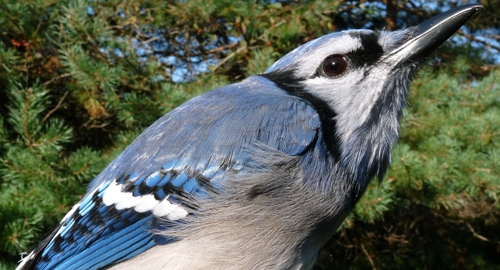 Blue Jays were quite active at MBO this week, at times haranguing Sharp-shinned or Cooper’s Hawks, and other times just moving about in small, noisy flocks. (Photo by Marcel Gahbauer)
Blue Jays were quite active at MBO this week, at times haranguing Sharp-shinned or Cooper’s Hawks, and other times just moving about in small, noisy flocks. (Photo by Marcel Gahbauer)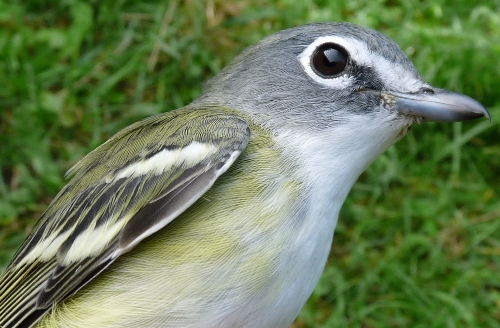 Sunday morning’s highlight was this Blue-headed Vireo, at long last our first one banded this fall. Later in the week two were heard singing, a rare sound at MBO in fall. (Photo by Marcel Gahbauer)
Sunday morning’s highlight was this Blue-headed Vireo, at long last our first one banded this fall. Later in the week two were heard singing, a rare sound at MBO in fall. (Photo by Marcel Gahbauer)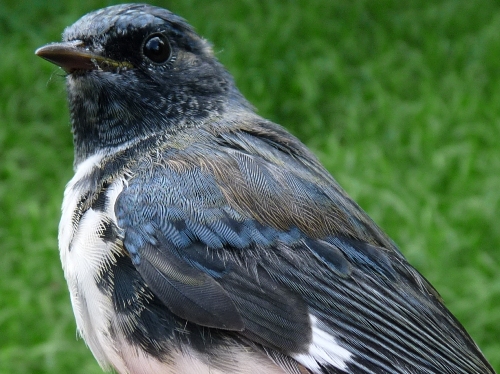 Black-throated Blue Warblers are striking birds, but like any others they can look quite scruffy when moulting. This young male is just in the process of replacing his greater coverts (visible growing in, with broad blue edges) and still has quite a bit of brown on the back. (Photo by Marcel Gahbauer)
Black-throated Blue Warblers are striking birds, but like any others they can look quite scruffy when moulting. This young male is just in the process of replacing his greater coverts (visible growing in, with broad blue edges) and still has quite a bit of brown on the back. (Photo by Marcel Gahbauer)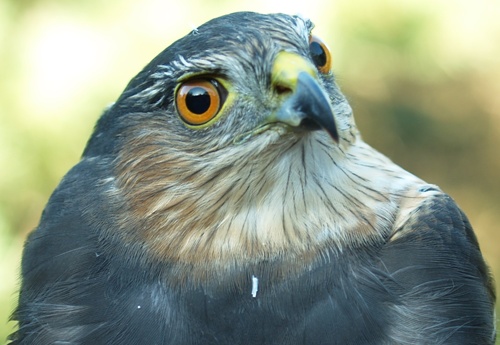 Okay, so a Sharp-shinned Hawk may not quite be a “blue” bird – but a second-year individual like the female above does have a rather blue-gray back. Usually almost all of the sharpies we catch are young birds, so it was a special opportunity to examine the plumage of an older bird for a change. (Photo by Simon Duval)
Okay, so a Sharp-shinned Hawk may not quite be a “blue” bird – but a second-year individual like the female above does have a rather blue-gray back. Usually almost all of the sharpies we catch are young birds, so it was a special opportunity to examine the plumage of an older bird for a change. (Photo by Simon Duval)
Week 8: September 19 – 25, 2009
|
|
|
|
MBO gratefully acknowledges the financial support provided for the 2009 Fall Migration Monitoring Program by TD Friends of the Environment Foundation |
| THIS WEEK | THIS FALL | 2009 TOTAL | SITE TOTAL | |
|---|---|---|---|---|
| # birds (and species) banded | 252 (34) | 1461 (69) | 2465 (82) | 21386 (105) |
| # birds (and species) repeat | 49 (12) | 286 (28) | 565 (42) | 3912 (66) |
| # birds (and species) return | 4 (2) | 30 (16) | 148 (32) | 602 (37) |
| # species observed | 82 | 127 | 161 | 198 |
| # net hours | 532.0 | 4109.0 | 7467.5 | 37932.8 |
| # birds banded / 100 net hours | 47.4 | 35.6 | 33.0 | 56.4 |
Note: table does not include nocturnal banding (owls)
Banders-in-charge: Simon Duval, Marcel Gahbauer, Gay Gruner
Assistants: Jess Adams, Christine Barrie, Jean Beaudreault, Melanie Bernstein, Sophie Cauchon, Jean Demers, Nicki Fleming, Barbara Frei, Alyssa Gangai, Nina Gauthier, Chloe Gendre, Tiffany Gilchrist, Bana Hamze, Marie-Anne Hudson, Daniel Jackson, Barbara MacDuff, Francine Marcoux, Meghan McDermott, Chris Murphy, André Pelletier, Victor Ramos, Ted Scodras, Clémence Soulard, Alex Stone, Rodger Titman, Carine Toumas, Matthew Von Bornhoft
Notes: This was the busiest week of the fall to date, but a far cry from the numbers seen at MBO at this time last year. On Thursday morning we had our busiest morning of the season with 57 birds banded, while other days were relatively steady with an average of 30 to 40 birds most days. With the pace of activity gradually picking up, we have high hopes that we are heading toward a healthy seasonal peak over the next two weeks, as in previous years.
It was a productive week for adding to our seasonal and annual lists of species observed and banded. Seen or heard for the first time this fall were Cackling Coose, Barred Owl, Winter Wren, American Pipit, Gray-cheeked Thrush, Connecticut Warbler, and White-crowned Sparrow. The Cackling Goose and Connecticut Warbler were the first for 2009 overall, and the warbler was actually only the second of its kind in our five-year history. As for birds banded, the Winter Wren was our first for 2009, and another four species were firsts for the fall: Golden-crowned Kinglet, Gray-cheeked Thrush, White-crowned Sparrow, and Slate-coloured Junco. It was a good week in general for observations, with the 83 species recorded above our typical average of around 80 for week 8.
|
|
Last year at this time we banded 170 Yellow-rumped Warblers during week 8; this week they didn’t even make the top 10 list. Similarly, in all of our previous four fall seasons, Ruby-crowned Kinglets have been in the top three; they too did not come close to making the top ten list this time. On the other hand, the 25 Magnolia Warblers are by far a record for this time of year, as they usually peak much earlier in September. Taken together, these observations suggest that perhaps migration is simply delayed this year.
While Magnolia Warblers were quite plentiful this week, they were still slightly outnumbered by the continuing abundance of Song Sparrows, and substantially fewer than the White-throated Sparrows that absolutely dominated this week’s totals. In fact, on Thursday morning alone, we banded 26 White-throats! Indigo Bunting and Black-throated Blue Warbler continue to be unusually numerous, tying for fifth place this week with Gray Catbirds and Nashville Warblers. We noted last week that Nashville Warblers have been relatively scarce this fall, and though they have made another appearance in the top 10 this week, their totals remain far below normal.
| # individuals banded | mean # individuals observed daily |
|---|---|
| 1. White-throated Sparrow (62) [1] | 1. Canada Goose (1166.4) [1] |
| 2. Song Sparrow (28) [2] | 2. American Crow (80.7) [5] |
| 3.Magnolia Warbler (25) [2] | 3. Cedar Waxwing (51.0) [4] |
| Common Yellowthroat (13) [6] | Common Grackle (50.0) [-] |
| 5. Gray Catbird (10) [-] | 5. White-throated Sparrow (37.0) [6] |
| 5. Nashville Warbler (10) [-] | 6. American Robin (36.9)[3] |
| 5. Black-throated Blue Warbler (10) [-] | 7. Blue Jay (25.7) [9] |
| 5. Indigo Bunting (10) [5] | 8. American Goldfinch (20.7) [8] |
| 9. Tennessee Warbler (7)[-] | 9. Red-winged Blackbird (20.7) [10] |
| 10. American Goldfinch (7) [-] | 10. Black-capped Chickadee (16.4) [7] |
Yet again Canada Goose numbers increased further this week, with a massive count of over 4300 individuals on Saturday contributing significantly to a daily average for the week of 1166! European Starlings made last week’s top ten list on the basis of a few large flocks flying by overhead; this week they were much scarcer and instead comparable flocks of Common Grackles took over their spot. Other than that, the remaining species in the top ten remained the same, just shuffled about, with American Crow and Cedar Waxwing dominating this week, while several other species increased substantially in numbers, even if their relative rankings dropped – of note, White-throated Sparrow, American Robin, and Blue Jay. It seems that there is a particularly large movement of Blue Jays this fall, which has also been noted by some birders elsewhere.
|
|
Week 9: September 26 – October 2, 2009
|
|
|
|
MBO gratefully acknowledges the financial support provided for the 2009 Fall Migration Monitoring Program by TD Friends of the Environment Foundation |
| THIS WEEK | THIS FALL | 2009 TOTAL | SITE TOTAL | |
|---|---|---|---|---|
| # birds (and species) banded | 371 (43) | 1832 (69) | 2836 (82) | 21757 (105) |
| # birds (and species) repeat | 93 (13) | 379 (33) | 658 (44) | 4005 (66) |
| # birds (and species) return | 2 (1) | 32 (16) | 150 (32) | 604 (37) |
| # species observed | 78 | 127 | 161 | 198 |
| # net hours | 459.0 | 4568.0 | 7926.5 | 38391.8 |
| # birds banded / 100 net hours | 80.8 | 40.1 | 35.7 | 56.7 |
Note: table does not include nocturnal banding (owls)
Banders-in-charge: Simon Duval, Gay Gruner
Assistants: Sheldon Andrews, Veronica Aponte, Christine Barrie, Jean Beaudreault, Jean Demers,Catherine Doucet, Shawn Craik, Nicki and Mike Fleming, Tiffany Gilchrist, Marie-Anne Hudson, Meg Langley, Barbara MacDuff, Dan Mardena, Meghna Marjadi, Alison Moore, Chris Murphy, Alex Stone, Clémence Soulard, Alexis Thorbecke, Rodger Titman, Carine Touma, Matthew Von Bornhoft
Notes: We’re pleased to report that for a second week in a row we can say we’ve had our busiest week of the fall to date – though on the other hand, it’s also true again that numbers pale in comparison to this time last year. In fact, while the 371 birds banded this week are nearly a 50% increase over last week’s count, the total is but a small fraction of the 1113 during the same time in 2008. Of course, last year we were experiencing the unprecedented invasion of Yellow-rumped Warblers at this time, while this year they only managed to make it into fourth place for the week. In previous years the total for week 9 ranged from 311 to 545, so we’re well within that range.
Having banded and observed a good diversity of species already this season, we actually ended up not adding any new species to either list this week. However, we had some species as repeats for the first time this fall (Ruby-crowned Kinglet, White-crowned Sparrow, and Purple Finch) or even for the year (Blue-headed Vireo and Gray-cheeked Thrush). We had some other interesting observations this week, including a few Northern Goshawk sightings, and a strong migration on Wednesday night that resulted in a nice fallout on Thursday morning with nearly 100 birds banded despite a morning shortened by rain. Among those we had at least half a dozen Blue-headed Vireos, contributing to our high total for the week of 21 – more than we’ve had in most full fall seasons! That day Ruby-crowned Kinglet and Yellow-rumped Warblers abounded, especially near the E nets, while the shrubs bordering the path between D and E were shivering with sparrows. More and more flocks of mixed blackbirds are being observed and a gang of screaming Blue Jays have been making themselves noticeable as they patrol the area.
The larger than usual numbers of Blue Jays migrating through MBO over the past few weeks and the Goshawk sightings this week are consistent with elements of the 2009-2010 “Winter Finch forecast” issued recently by Ron Pittaway of the Ontario Field Ornithologists. Based on an expected decline of snowshoe hare and Ruffed Grouse in northern Ontario, the fall flight of Northern Goshawks should be above average this year and/or next year, while the nut crops (acorn, beech, hazelnut) in Ontario were for the most part poor, forcing the Blue Jays to move south. While conditions might be somewhat different in Quebec, chances are there are similarities, and our observations support that. As for the finches … the review of cone and seed crops across Canada suggests that it may be a relatively quiet winter for finch-watching at MBO, but we hope to monitor the site throughout winter all the same and perhaps find at least a few species hanging around our feeders. But before we get to that, we still have a few final weeks of fall migration to enjoy.
|
|
Just like last week, White-throated and Song Sparrows account for the top two species banded this week, with the White-throats commandingly in the lead. Ruby-crowned Kinglets, which have in all previous years been in second place during week 9, were finally picking up in numbers and landed in third place. Blue-headed Vireos in fourth place were unexpectedly abundant, while at the other extreme Yellow-rumped Warblers were tied for fourth place, but were surprisingly scarce. But it seems like they are exhibiting a substantial two-year cycle in numbers … in odd-numbered years we have had relatively few Yellow-rumped Warblers during this week (21, 12, and 21), while in even years we’ve had at least ten times more (236 and 688). Obviously the population itself can’t be changing that much from year to year, so to some degree the variability must be a function of the birds following different migratory strategies. Needless to say, we’re very curious to see whether we are in for a big influx again next fall. Lower down the list, Nashville and Magnolia Warblers are still being banded in decent numbers, and yet again the Black-throated Blue Warblers were numerous enough to squeak into the list. Hermit Thrushes rounded out this week’s top ten.
| # individuals banded | mean # individuals observed daily |
|---|---|
| 1. White-throated Sparrow (100) [1] | 1. Canada Goose (757.7) [1] |
| 2. Song Sparrow (50) [2] | 2. Common Grackle (79.9) [4] |
| 3.Ruby-crowned Kinglet (45) [-] | 3. American Robin (68.4) [6] |
| Blue-headed Vireo (21) [-] | White-throated Sparrow (68.3) [5] |
| Yellow-rumped Warbler (21) [-] | 5. American Crow (47.0) [2] |
| 6. White-crowned Sparrow (14) [-] | 6. European Starling (34.7)[-] |
| 7. Nashville Warbler (13) [5] | 7. Blue Jay (26.7) [7] |
| 8. Magnolia Warbler (11) [3] | 8. Song Sparrow (25.9) [-] |
| 9. Black-throated Blue Warbler (8)[5] 9. Hermit Thrush (8) [-] |
8. Cedar Waxwing (23.9) [3] |
| 10. Black-capped Chickadee (20.7) [10] |
Nearly by a factor of ten, Canada Goose remained the most numerous species observed this week. Common Grackle, American Robin, and White-throated Sparrow have all been on the increase, while American Crows and Cedar Waxwings were noticeably less common this week. European Starling and Song Sparrow vaulted on to the top ten list this week, while American Goldfinch and Red-winged Blackbirds were pushed off. Black-capped Chickadees and Blue Jays held their positions, both probably on the strength of migrants moving through, augmenting the number of local residents.
|
|
Week 10: October 3 – 9, 2009
|
|
|
|
MBO gratefully acknowledges the financial support provided for the 2009 Fall Migration Monitoring Program by TD Friends of the Environment Foundation |
| THIS WEEK | THIS FALL | 2009 TOTAL | SITE TOTAL | |
|---|---|---|---|---|
| # birds (and species) banded | 591 (36) | 2423 (71) | 3427 (82) | 22348 (105) |
| # birds (and species) repeat | 66 (10) | 445 (34) | 724 (45) | 4071 (66) |
| # birds (and species) return | 2 (2) | 34 (16) | 152 (32) | 606 (37) |
| # species observed | 70 | 130 | 162 | 198 |
| # net hours | 359.5 | 4927.5 | 8286.0 | 38751.3 |
| # birds banded / 100 net hours | 164.3 | 49.2 | 41.3 | 57.6 |
Note: table does not include nocturnal banding (owls)
Banders-in-charge: Simon Duval, Marcel Gahbauer, Gay Gruner
Assistants: Jean Bacon, Christine Barrie, Jean Beaudreault, Shawn Craik, Jenia Faibusovitch, Nicki Fleming, Barbara Frei, Tiffany Gilchrist, Jennifer Gruner, Audrey Hihasigiwi, Marie-Anne Hudson, Meg Langley, Barbara MacDuff, Shawn McNamee, Mahmoud Moghrabi, Chris Murphy, Marissa Nolan, Lily Soucy, Alex Stone, Alexis Thorbecke,Rodger Titman, Carine Toumas, Matthew Von Bornhoft, Davis Wood
Notes: Back in August, this fall’s weekly reports often commented on the record number of birds we were banding … and in contrast, most of the September reports pointed out that our numbers for that period were below average. Well, now that we are solidly into October, it appears the pendulum has at least temporarily swung back the other way again. The 588 birds we banded this week represent the third-busiest week in MBO’s history, behind only weeks 9 and 10 from last fall. And this despite losing Friday entirely to rain, and also having Saturday’s efforts severely curtailed by the weather. On four of the five remaining days, we banded over 100 individuals, capped by 166 on Thursday, our busiest day this year. For the season we remain somewhat below average in many categories (cumulative number of species observed and banded, individuals banded, birds banded per 100 net hours), but if the trend from this week carries over at all into week 11, at least some of these may begin to approach the levels more typical of 2005 – 2007.
Three Red-breasted Mergansers seen flying over the site on Wednesday morning were a first sight record for MBO this year, while Fox Sparrow and House Sparrow were recorded for the first time this fall. Fox Sparrow was also banded for the first time this season, as was Northern Parula – a species that normally comes through MBO almost a month earlier, and that we were quite sure we had missed for the year!
|
|
Ruby-crowned Kinglets were by far the species most frequently banded this week, largely on the strength of 77 individuals on Thursday alone, representing nearly half our total catch that day. White-throated Sparrows slipped down to second place this week, but were still abundant. These two species have been in our top three for week 10 every year, so in that sense the current state of migration appears to be quite typical. Although in third place with 70 individuals, Yellow-rumped Warblers are only around 10% as numerous as during the same period last year! At the other extreme, the 46 White-crowned Sparrows banded represent a new single-week record for MBO, and the 37 Hermit Thrushes banded are more in one week than we’ve ever had in an entire season! Rounding out the top 10 for this week, Song Sparrow and Blue-headed Vireo continue their unusually strong showings, while American Robin, Slate-coloured Junco, and Golden-crowned Kinglet numbers are building.
|
|
With respect to species observed, Canada Goose remains on top for a sixth consecutive week, hardly a surprise given that in all our five fall seasons they have been the most abundant species in both weeks 9 and 10. American Robin numbers seem to be building earlier than usual, while average counts for the week were higher than we’ve ever had before for both White-throated and White-crowned Sparrows – the bushes were just teeming with them day after day! Large mixed flocks of blackbirds were common throughout the week, with European Starling and Red-winged Blackbird most abundant, followed by Common Grackle, but increasing numbers of Rusty Blackbirds as the week progressed. Increases in the number of some of these birds, as well as other early October peak migrants such as Ruby-crowned Kinglet and Yellow-rumped Warbler caused some of our “regulars” to drop off this week’s list, namely Blue Jay, Black-capped Chickadee, Cedar Waxwing, and Song Sparrow.
| # individuals banded | mean # individuals observed daily |
|---|---|
| 1. Ruby-crowned Kinglet (159) [3] | 1. Canada Goose (257.6) [1] |
| 2. White-throated Sparrow (103) [1] | 2. American Robin (153.9) [3] |
| 3. Yellow-rumped Warbler (70) [4] | 3. White-throated Sparrow (103.0) [4] |
| 4. White-crowned Sparrow (46) [6] | 4. European Starling (74.7) [6] |
| 5. Hermit Thrush (37) [9] | 5. Red-winged Blackbird (60.6) [-] |
| 6. Song Sparrow (33) [2] | 6. White-crowned Sparrow (42.9) [-] |
| 7. American Robin (22) [-] | 7. American Crow (40.1) [5] |
| 8. Slate-coloured Junco (21) [-] | 8. Ruby-crowned Kinglet (37.4) [-] |
| 9. Blue-headed Vireo (15) [4] | 9. Common Grackle (24.1) [2] |
| 10. Golden-crowned Kinglet (10) [-] | 10. Yellow-rumped Warbler (24.0) [-] |
In closing this week, special thanks to the volunteers who make “big weeks” like this one possible. Even the most experienced, talented, and efficient banders can only handle a certain number of birds in a given time. Without the great help from this week’s extractors, runners, and scribes (sometimes doing double or even triple-duty!), the banders would have been forced to curtail efforts substantially. Just as importantly, censusers and other observers are of especially critical importance during such peak periods, given that the bander(s) and scribe(s) are stuck inside for a much larger part of the morning. The very healthy mean numbers of individuals seen daily are testament to the great job done by this week’s observers. We have another three weeks left in this fall season, and look forward to more great work from the whole team!
|
|
Week 11: October 10 – 16, 2009
|
|
|
|
MBO gratefully acknowledges the financial support provided for the 2009 Fall Migration Monitoring Program by TD Friends of the Environment Foundation |
| THIS WEEK | THIS FALL | 2009 TOTAL | SITE TOTAL | |
|---|---|---|---|---|
| # birds (and species) banded | 257 (22) | 2680 (72) | 3684 (82) | 22605 (105) |
| # birds (and species) repeat | 38 (8) | 483 (35) | 762 (46) | 4109 (66) |
| # birds (and species) return | 1 (1) | 35 (16) | 153 (32) | 607 (37) |
| # species observed | 65 | 132 | 163 | 198 |
| # net hours | 225.5 | 5153.0 | 8511.5 | 38976.8 |
| # birds banded / 100 net hours | 114.0 | 52.0 | 43.2 | 58.0 |
Note: table does not include nocturnal banding (owls)
Banders-in-charge: Simon Duval, Marcel Gahbauer, Gay Gruner
Assistants: Jessica Adams, Shawn Craik, Jean Demers, Matthew Emrich, Nicki Fleming, Tiffany Gilchrist, Jeff Harrison, Marie-Anne Hudson, Marie Melissa Kalamaras, Meg Langley, Francine Marcoux, Dan McDonough, Chris Murphy, Clémence Soulard, Alex Stone, Alexis Thorbecke, Rodger Titman, Carine Touma
Notes: As is sometimes the case in later fall, weather was the story of the week. For the first three days we had close to seasonal temperatures, but lost nearly half our normal net hours to rain and/or wind. However, the site was teeming with birds – an average of over 40 species observed each day, and 190 birds banded in just 136 net hours. Then on Tuesday a cold front came through, accompanied by rain, wiping out everything but census. For the remainder of the week it remained 6 – 8 degrees Celsius colder than usual for this time of year, to the extent that we had to severely curtail the opening of nets. During this part of the week our average daily count of species was down to around 30, and we banded just 66 birds in 92.5 net hours. The 22 species banded this week is a sharp drop in diversity from last week’s 37, but this is actually quite typical of weeks 10 and 11 at MBO … there is usually a big change in the bird community right around Thanksgiving.
Before going on to the rest of this week’s regular news, a brief tangent on the subject of owls is in order. In 2004, 2005, 2007, and again this fall we have supplemented our standardized migration monitoring program with a bit of nocturnal effort to catch and band Northern Saw-whet Owls. For various reasons, but largely due to a limited availability of qualified banders, we haven’t been able to operate the owl banding program as consistently as we’d like. However, we’ve always felt the effort is worthwhile since there is much yet to be learned about these birds and the relatively high rate of recaptures for this species improves our chances of connecting some dots on the landscape over time (e.g. one of the birds we caught in 2004 had been banded near Kingston, Ontario three years earlier). During our three previous owl banding attempts at MBO we had modest results at best, with season totals ranging from 15 to 17 individuals banded.
This fall, largely thanks to the determination of our BIC Simon Duval, we decided to give the owling another chance, but we moved the nets to a new location, near the existing E1 net, and going around and through a small fir/spruce stand. We hoped this would improve our results, but never expected the change to be as dramatic as it has been. On Tuesday night alone we banded 17 saw-whets – as many in one night as our previous best season! We also had 12 the night before, and 13 over the rest of the week, for a total of 42 (which would put them as #3 on the weekly chart below if they counted toward it). For the season we are now at 50, and we expect at least a few are yet to come. Perhaps most intriguing is that most other saw-whet banders in the northeast are reporting this to be a below average year in terms of numbers (saw-whets have quite a dramatic four-year population cycle), so we are very excited to see how our new site will fare when we have a “good” year!
|
|
Additions to our seasonal and annual lists were sparse this week. American Tree Sparrow was observed and banded for the first time this wall, while Wilson’s Snipe was observed for the first time this year. We also had our first junco recapture of the year this week. Other late season species such as Northern Shrike and “winter finches” have yet to make an appearance despite the cold weather in the second half of this week, but we expect them soon.
|
|
As mentioned earlier, there tends to be quite a significant turnover of birds at MBO around mid-October, and the list of species banded most frequently this week reflects those changes. Our two late-fall specialists, American Robin and Slate-coloured Junco, have settled into the top two spots, and it would be not surprising to see them remain there (or at least close to the top) for the remaining two weeks as well. The biggest surprise this week is the continuing abundance of Hermit Thrushes, bringing our seasonal total to 80 individuals, more than double our count from any previous season (and of note we also had 19 repeats this week, many of birds we banded last week, so some are clearly hanging around and enjoying the feeding opportunities at MBO). Ruby-crowned Kinglet, White-throated Sparrow, and White-crowned Sparrow were all still reasonably numerous early in the week, but are sliding down the list as most of them moved out when the cold front arrived. Black-capped Chickadees were banded in good numbers this week, suggesting that there may be somewhat of a migration underway after all (we have seen substantial movements in “odd” years previously, but no big push of birds yet this fall). Song Sparrows continue to move in decent numbers, with this week’s 12 birds bringing our season to 301, far above our normal count for them, and just one shy of the record we set in 2006.
| # individuals banded | mean # individuals observed daily |
|---|---|
| 1. American Robin (51) [7] | 1. American Robin (403.0) [2] |
| 2. Slate-coloured Junco (46) [8] | 2. Canada Goose (168.9) [1] |
| 3. Hermit Thrush (34) [5] | 3. Red-winged Blackbird (153.0) [5] |
| Ruby-crowned Kinglet (33) [1] | American Crow (112.6) [7] |
| 5. White-throated Sparrow (32) [2] | 5. White-throated Sparrow (62.9) [3] |
| 6. Black-capped Chickadee (15) [-] | 6. European Starling (53.1) [4] |
| 7. Song Sparrow (12) [6] | 7. Slate-coloured Junco (33.7) [-] |
| 8. White-crowned Sparrow (9) [4] | 8. Black-capped Chickadee (18.1) [-] |
| 9. Swamp Sparrow (6) [-] | 9. White-crowned Sparrow (17.6) [6] |
| 10. Blue-headed Vireo (3) [9] | 10. Ruby-crowned Kinglet (15.0) [8] |
Like last year at this time, Canada Goose numbers have tapered off a bit, while clouds of swirling American Robins have taken over the site and the top spot on the list of species most frequently observed for the week. In the second half of the week Red-winged Blackbirds were nearly as abundant as the robins, bringing them to third place for the week. The local American Crow roost appears to be building in size again, and we continued to have flocks of European Starlings fly over the site most days this week, occasionally even stopping to perch in some of the taller trees on occasion. Thanks largely to phenomenal numbers over the first couple of days of the week, White-throated and White-crowned Sparrows remain in the top 10, but are likely to drop out next week unless a large number of late migrants are waiting to move south through MBO. The surge in the arrival of Slate-coloured Juncos resulted in them being added to this week’s list, and Black-capped Chickadees returned after an absence of one week, boosted a bit by the arrival of apparent migrants. Common Grackle and Yellow-rumped Warbler were the two species on the list last week that fell off this week as their numbers dropped.
We have just two weeks left in this year’s Fall Migration Monitoring Program, and with the cold weather of the past few days it feels in some ways like the end of the season should be coming even sooner! But we take heart in the warming trend shown in the long-range weather forecast, and hope that we’ll have a good finish to the season … no doubt with many more robins and juncos, but perhaps also a few surprises still. After all, some very northern breeders have yet to put in an appearance at MBO this fall, and with the early cold snap there may be increased opportunities to spot some of them, whether in the nets (e.g. shrikes or finches) or overhead (e.g. raptors and waterfowl).
|
|
Week 12: October 17 – 23, 2009
|
|
|
|
MBO gratefully acknowledges the financial support provided for the 2009 Fall Migration Monitoring Program by TD Friends of the Environment Foundation |
| THIS WEEK | THIS FALL | 2009 TOTAL | SITE TOTAL | |
|---|---|---|---|---|
| # birds (and species) banded | 359 (20) | 3039 (73) | 4043 (82) | 22964 (105) |
| # birds (and species) repeat | 50 (9) | 533 (37) | 810 (48) | 4159 (66) |
| # birds (and species) return | 5 (3) | 40 (18) | 158 (32) | 612 (37) |
| # species observed | 52 | 135 | 163 | 198 |
| # net hours | 307.0 | 5460.0 | 8818.5 | 39283.8 |
| # birds banded / 100 net hours | 116.9 | 55.6 | 45.8 | 58.5 |
Note: table does not include nocturnal banding (owls)
Banders-in-charge: Simon Duval, Marcel Gahbauer, Gay Gruner
Assistants: Josiane Alarie, Christine Barrie, Melanie Bernstein, Jean Demers, Amélie Drolet, Nicki Fleming, Tiffany Gilchrist, Jeff Harrison, Kaja Verret Holding, Marie-Melissa Kalamaras, Sharon Kelly, Meg Langley, Gabrielle Laurent, Barbara MacDuff, Meaghan McDermott, Chris Murphy, Ted Murphy-Kelly, Lily Soucy, Clémence Soulard, Raphaëlle Thomas, Rodger Titman, Carine Toumas, Matthew Von Bornhoft
Notes: This is traditionally the time of year when things start to get quieter at MBO, but this week proved to be an exception to that pattern. Not only did our numbers increase over last week, but we had the highest number of birds (and diversity of species) ever banded in week 12! A return to more seasonal temperatures no doubt played a role in this week’s migration. On Friday, we banded our 3000th bird of this fall, a milestone we’ve reached in four of our five fall migration monitoring programs.
We added another three species to our list of birds seen this fall – Great Black-backed Gull, Killdeer, and Field Sparrow. None of the species we banded this week were new for the season, but we did have our first Blue Jay and American Robin returns of the fall.
While Simon and Gay were busy keeping things running smoothly at MBO, Marcel and Marie-Anne headed up to Tadoussac this week for a four-day meeting of the Canadian Migration Monitoring Network. This group, comprised of members from 28 bird observatories across Canada as well as representatives from Bird Studies Canada and Environment Canada, meets every second fall to discuss issues related to migration monitoring, including ways in which members can collaborate to improve scientific accuracy and output. As always it was a very positive, interesting, and productive experience, and over the winter we will consider tweaking some elements of our operations at MBO to incorporate ideas discussed at this meeting.
|
|
Last week we commented on the phenomenal week of owl banding we had. This week numbers were much more modest, with only 7 more individuals banded. However, in addition to them, we had two foreign recaptures, i.e. birds that had previously been caught and banded elsewhere. One was a female banded as a second-year bird at Whitefish Point in northern Michigan in July 2008, while the other one was also a female, banded on migration in Shenandoah State Park, Virginia, in November 2008. In an earlier year we also recaptured a saw-whet banded at Prince Edward Point, Ontario … so we figure it is about time that someone else finds and reports one of the owls we have banded at MBO!
For a second straight week, Slate-coloured Junco and American Robin remained distinctly on top as the most frequently banded species, but with the juncos taking the lead this week. White-throated Sparrows continue to move through in decent numbers, and while the chickadee migration isn’t overwhelming this year, the fact that we banded 31 this week certainly indicates that they are on their way through as well. However, the most surprising entry on this week’s list of species banded is Red-winged Blackbird. While we band plenty in spring, they usually stay high in fall and we’ve never before banded more than 7 in an entire fall season. This year we hadn’t caught a single one heading into this week, so to band 30 this week alone was quite remarkable. Needless to say, this is one species for which fall banding counts aren’t terribly meaningful at MBO; rather we need to consider the number of individuals observed daily as a better indicator of their abundance. The bottom half of this week’s list was rounded out by the omni-present Song Sparrow, new arrivals in the form of Fox Sparrow and American Tree Sparrow, and some late-lingering kinglets (both Ruby-crowned and Golden-crowned).
| # individuals banded | mean # individuals observed daily |
|---|---|
| 1. Slate-coloured Junco (109) [2] | 1. Red-winged Blackbird (334.4) [3] |
| 2. American Robin (96) [1] | 2. American Robin (321.4) [1] |
| 3. White-throated Sparrow (35) [5] | 3. Canada Goose (166.1) [2] |
| Black-capped Chickadee (31) [6] | American Crow (103.3) [4] |
| 5. Red-winged Blackbird (30) [-] | 5. Slate-coloured Junco (37.1) [7] |
| 6. Song Sparrow (12) [7] | 6. Black-capped Chickadee (26.1) [8] |
| 7. Fox Sparrow (9) [-] | 7. European Starling (25.7) [6] |
| 8. Ruby-crowned Kinglet (8) [4] | 8. White-throated Sparrow (22.6) [5] |
| 9. American Tree Sparrow (7) [-] | 9. Common Grackle (18.4) [-] |
| 10. Golden-crowned Kinglet (6) [9] | 10. Blue Jay (9.7) [-] |
We usually see large Red-winged Blackbird flocks at this time of fall, but this year they seem to be larger than ever. On average they slightly outnumbered American Robins this week, which in turn were almost twice as numerous as Canada Geese. American Crows remain very numberous, while both juncos and chickadees were migrating through in large enough numbers daily to make it to the middle of this week’s list. Starlings and Common Grackles flew overhead in large flocks at times, while there are still plenty of White-throated Sparrows singing away around dawn most mornings, and the Blue Jays appear to be enjoying the corn in the neighbouring field. White-crowned Sparrow and Ruby-crowned Kinglet dropped off from last week’s list, and we don’t expect to see them in any numbers again until early next May.
We have just two weeks left in this year’s Fall Migration Monitoring Program, and with the cold weather of the past few days it feels in some ways like the end of the season should be coming even sooner! But we take heart in the warming trend shown in the long-range weather forecast, and hope that we’ll have a good finish to the season … no doubt with many more robins and juncos, but perhaps also a few surprises still. After all, some very northern breeders have yet to put in an appearance at MBO this fall, and with the early cold snap there may be increased opportunities to spot some of them, whether in the nets (e.g. shrikes or finches) or overhead (e.g. raptors and waterfowl).
|
|
Week 13: October 24 – 30, 2009
|
|
|
|
MBO gratefully acknowledges the financial support provided for the 2009 Fall Migration Monitoring Program by TD Friends of the Environment Foundation |
| THIS WEEK | THIS FALL | 2009 TOTAL | SITE TOTAL | |
|---|---|---|---|---|
| # birds (and species) banded | 351 (19) | 3390 (75) | 4394 (84) | 23315 (105) |
| # birds (and species) repeat | 73 (9) | 606 (39) | 885 (50) | 4232 (66) |
| # birds (and species) return | 2 (2) | 42 (18) | 160 (32) | 614 (37) |
| # species observed | 52 | 143 | 166 | 199 |
| # net hours | 377.4 | 5837.4 | 9195.9 | 39661.2 |
| # birds banded / 100 net hours | 93.0 | 58.1 | 47.7 | 58.8 |
Note: table does not include nocturnal banding (owls)
Banders-in-charge: Simon Duval, Marcel Gahbauer, Gay Gruner
Assistants: Christine Barrie, Jean Demers, Matthew Emrich, Nicki Fleming, Alyssa Gangai, Tiffany Gilchrist, Jeff Harrison, Marie-Anne Hudson, Daniel Jackson, Meg Langley, Melissa Lefebvre, Barbara MacDuff, Meghna Marjadi, Allison Moore, Chris Murphy, Ted Scodras, Clémence Soulard, Alex Stone, Rodger Titman, Carine Toumas
Notes: What an end to the season! We’re used to numbers tapering off significantly in the final week of October, validating our decision to call an end to fall migration monitoring at that point. But this year week 13 was productive from beginning to end, with almost 50% more birds banded than in our previous best year, including 66 on our final day of the season. Out of curiosity, we will unofficially extend the season by one week to see just when the numbers do taper off this year … the data will not count toward our fall totals for 2009, but may give us some insight into whether we need to consider adjusting our monitoring window in the future.
Not only did we band a surprisingly high number of birds this week, but it was also good for observations. For the second time this year, we added our only new site species of the season on its final day. For spring migration, it was a Carolina Wren; this time it was a Townsend’s Solitaire that flew by and gave away its identity via its song on Friday’s census, becoming the 199th species recorded at MBO. We also managed to add two species to our list of birds observed at MBO this year (Northern Pintail and Long-eared Owl), plus another five that we hadn’t yet seen this fall (Green-winged Teal, Northern Shoveler, Rough-legged Hawk, Golden Eagle, and Northern Shrike). The Northern Shrike was also the first one banded this year, as was a White-breasted Nuthatch.
|
|
Since we have been reporting on our owl banding efforts, a quick update is in order. It was another rather modest week, with another 7 saw-whets banded, bringing our season total to 6 Since we have had some success in early November in past years, we will continue that program a bit longer to see whether we can band any late stragglers. But even if we don’t catch any more, we’ve already had a phenomenal year, banding roughly four times as many as in previous seasons, and getting data on two foreign recoveries, mentioned in last week’s report.
|
|
Slate-coloured Junco remained the most frequently banded species for a second week, and by a large margin this time over American Tree Sparrow, which have jumped up from near the bottom of last week’s list. Conversely, American Robin has fallen far down the list, despite being #1 at this time for the past three years. Black-capped Chickadees continued to migrate in good numbers with this week’s count bringing us to 75 over the past two weeks, and over 150 for the season, keeping true for a fifth year to our observation of a two-year cycle in the number of migrants of this species at MBO. Fox Sparrows also kept coming strong this week, and we continued to band new Song Sparrows this week, enough so that they managed to rank in the top 7 for every week this fall. Overall it was a great fall for sparrows, with record numbers banded for Fox, American Tree, White-throated, Song, and Junco – and with the latter three representing the top three species for the season on the whole. Again the two kinglets rounded out the end of this week’s top ten, this time with a few late Swamp Sparrows keeping them company.
| # individuals banded | mean # individuals observed daily |
|---|---|
| 1. Slate-coloured Junco (175) [1] | 1. Red-winged Blackbird (465.0) [1] |
| 2. American Tree Sparrow (54) [9] | 2. American Robin (173.9) [2] |
| 3. Black-capped Chickadee (44) [4] | 3. American Crow (142.9) [4] |
| 4. White-throated Sparrow (22) [3] | 4. Canada Goose (91.3) [3] |
| 5. Fox Sparrow (17) [7] | 5. Slate-coloured Junco (71.1) [5] |
| 6. Song Sparrow (9) [6] | 6. Mallard (33.4) [-] |
| 6. American Robin (9) [2] | 7. Black-capped Chickadee (28.9) [6] |
| 8. Ruby-crowned Kinglet (4) [8] | 8. White-throated Sparrow (21.9) [8] |
| 9. Golden-crowned Kinglet (3) [10] | 9. American Tree Sparrow (16.4) [-] |
| 9. Swamp Sparrow (3) [-] | 10. European Starling (14.7) [7] |
Again this week Red-winged Blackbirds came out with the highest daily average of individuals observed, though in this case it was largely on the strength of over 2000 individuals flying over the site on Tuesday morning (including one massive flock estimated at 1200 birds). American Robins were more consistent, but most were flying high, accounting for the very small percentage that ended up in the nets. The rest of the top five also remained fairly consistent, except for American Crow and Canada Goose swapping positions. Black-capped Chickadee and White-throated Sparrow remained numerous enough on migration to stay in the bottom half of the list, while American Tree Sparrow increased enough to be added to the list, and nearly daily flights of Mallards gave us our first non-goose waterfowl entry in a long while.
It has been a long season, and we are ready to shift to a much lower gear for winter. We will as always be putting together a seasonal report summarizing all of the fall 2009 results, and will post it to the website when it is ready, hopefully before the end of December. But for now, we want to express our heartfelt thanks to everyone who contributed to making our fifth full fall season at MBO a resounding success – we couldn’t have done it without the support of all the volunteers listed at the top of each weekly report, as well as those helping out behind the scenes with site management, fundraising, and logistics. Thank you all, and we look forward to your continued involvement in 2010 and beyond!
|
|
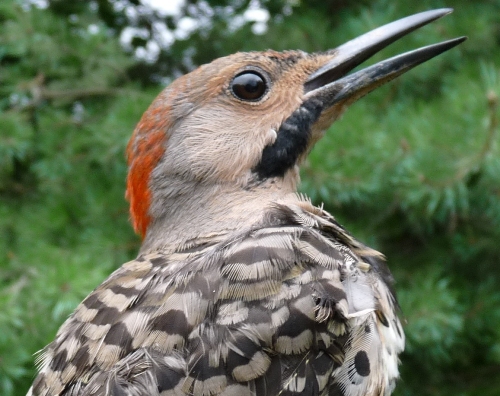 Last fall marked the first time that we banded three flickers in a season; this year we’ve already managed to reach that total just in our first week of operation! We caught three apparent brothers, all at pretty much the same stage of moulting their primaries, scattered across three different nets on Tuesday and Thursday this week. (Photo by Marcel Gahbauer)
Last fall marked the first time that we banded three flickers in a season; this year we’ve already managed to reach that total just in our first week of operation! We caught three apparent brothers, all at pretty much the same stage of moulting their primaries, scattered across three different nets on Tuesday and Thursday this week. (Photo by Marcel Gahbauer)
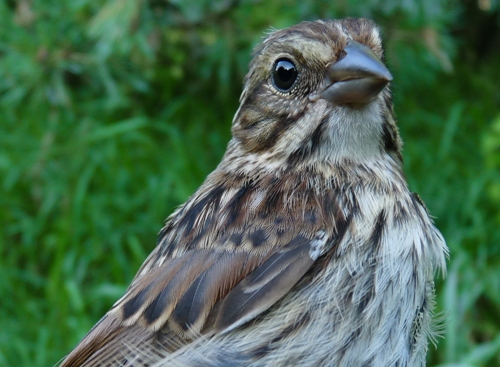 One of the great challenges each summer and early fall is figuring out the subtle distinctions among juvenile sparrows. Have a look at the one above and two below, then scroll down to below our “milestone” Yellow Warbler to check whether your ID of these three birds matches ours. (Photos by Marcel Gahbauer)
One of the great challenges each summer and early fall is figuring out the subtle distinctions among juvenile sparrows. Have a look at the one above and two below, then scroll down to below our “milestone” Yellow Warbler to check whether your ID of these three birds matches ours. (Photos by Marcel Gahbauer)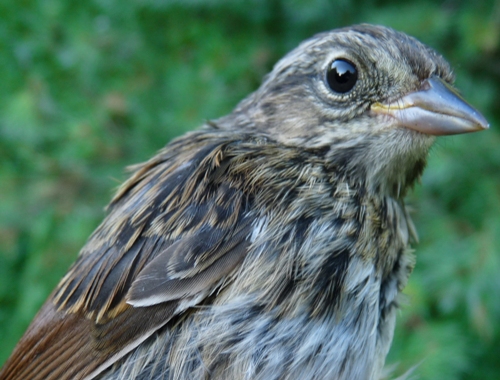
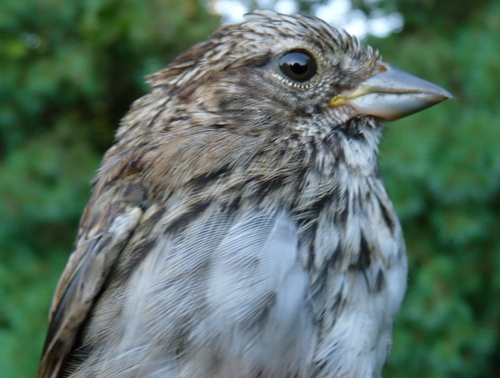 On the second day of the season, we banded our 20,000th bird at MBO … rather appropriately (given that it is the basis of the silhouette in our logo) it was a Yellow Warbler (Photo by Marcel Gahbauer)
On the second day of the season, we banded our 20,000th bird at MBO … rather appropriately (given that it is the basis of the silhouette in our logo) it was a Yellow Warbler (Photo by Marcel Gahbauer)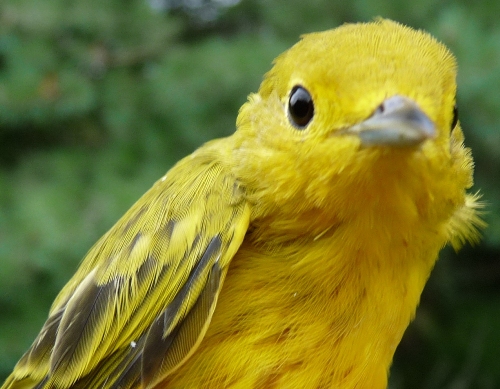
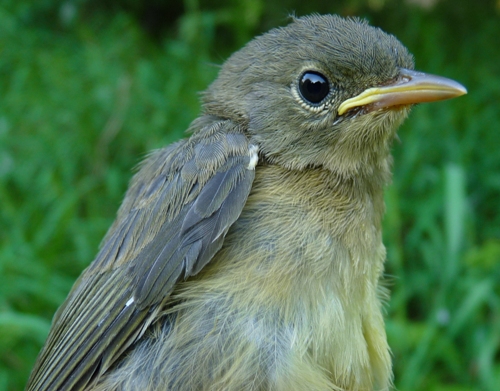 Banding in the early part of August means we see our share of fledglings just out of the nest, like this Common Yellowthroat. (Photo by Marcel Gahbauer)
Banding in the early part of August means we see our share of fledglings just out of the nest, like this Common Yellowthroat. (Photo by Marcel Gahbauer)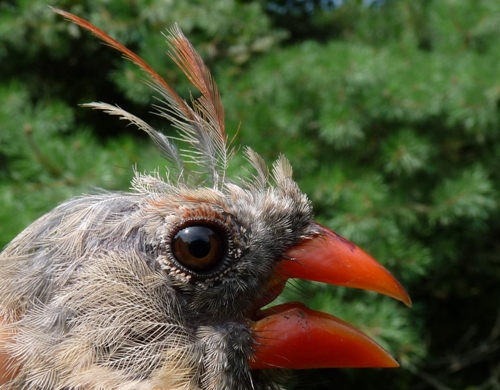 August banding also brings with it an opportunity to see many species in various stages of moult, some like this female Northern Cardinal looking rather undignified in the process. (Photo by Marcel Gahbauer)
August banding also brings with it an opportunity to see many species in various stages of moult, some like this female Northern Cardinal looking rather undignified in the process. (Photo by Marcel Gahbauer)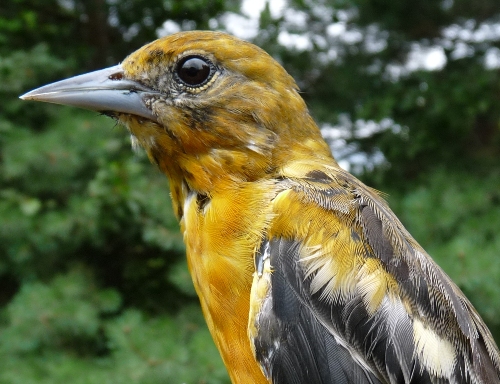 Of course with this being our 5th full fall migration season, we also have the potential to recapture ever older returns of birds from our “early years”. This female Baltimore Oriole was banded at MBO as an after-hatch-year bird in 2005, making her now at least 5 years old and a veteran of at least 10 migratory flights to/from the Neotropics. While we recapture many of our local orioles annually, this was our first recapture of her since 2005, so we don’t know whether she has just been good at avoiding our nets most years, or has been breeding elsewhere for the past three summers. (Photo by Marcel Gahbauer)
Of course with this being our 5th full fall migration season, we also have the potential to recapture ever older returns of birds from our “early years”. This female Baltimore Oriole was banded at MBO as an after-hatch-year bird in 2005, making her now at least 5 years old and a veteran of at least 10 migratory flights to/from the Neotropics. While we recapture many of our local orioles annually, this was our first recapture of her since 2005, so we don’t know whether she has just been good at avoiding our nets most years, or has been breeding elsewhere for the past three summers. (Photo by Marcel Gahbauer)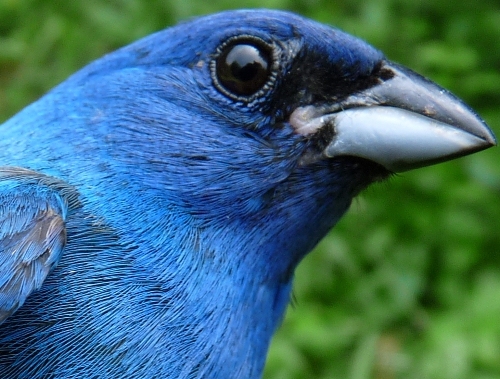 By August, most of the breeding birds at MBO have become rather quiet, or have even already departed for staging grounds elsewhere, such as the blackbirds and swallows do each July. But so far this August we’ve always been able to count on a couple of male Indigo Buntings belting out their cheery song all morning long, every day. This one, banded last year around this time, paid us a return visit in the nets this week. (Photo by Marcel Gahbauer)
By August, most of the breeding birds at MBO have become rather quiet, or have even already departed for staging grounds elsewhere, such as the blackbirds and swallows do each July. But so far this August we’ve always been able to count on a couple of male Indigo Buntings belting out their cheery song all morning long, every day. This one, banded last year around this time, paid us a return visit in the nets this week. (Photo by Marcel Gahbauer)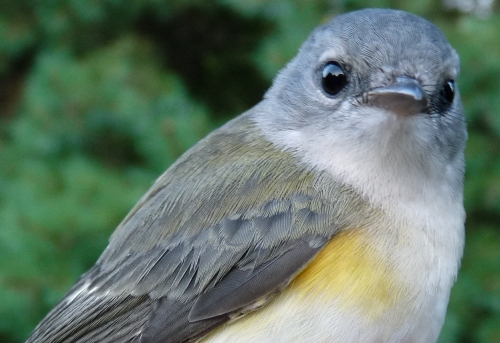 American Redstarts are one of our more common warblers each August, so we have started looking more closely at the variation in the colour of the patch on the side of the breast, classifying each one according to the “Naturalist’s Color Guide”. Above is a young male with “orange yellow” patches, while below is a female with “straw yellow” (Photos by Marcel Gahbauer)
American Redstarts are one of our more common warblers each August, so we have started looking more closely at the variation in the colour of the patch on the side of the breast, classifying each one according to the “Naturalist’s Color Guide”. Above is a young male with “orange yellow” patches, while below is a female with “straw yellow” (Photos by Marcel Gahbauer)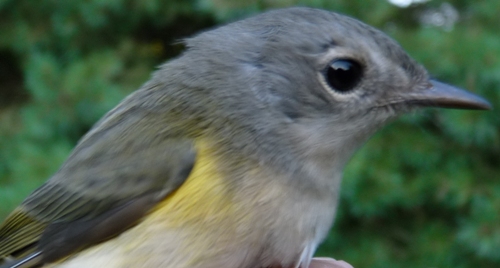
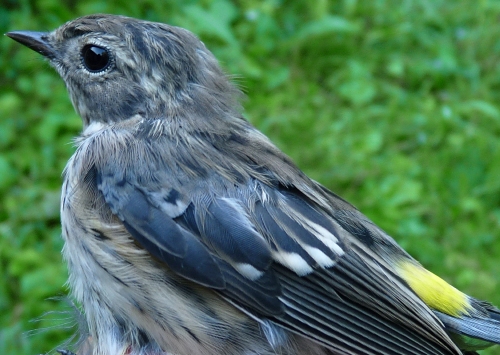 Surely it isn’t Yellow-rumped Warbler season yet! Last fall, MBO experienced an unprecedented invasion of these birds from late September to mid-October, and we don’t expect to see numbers like that again this fall. So, we were very surprised to catch this very young individual, the earliest in fall that we’ve ever banded one, by more than two weeks. (Photo by Marcel Gahbauer)
Surely it isn’t Yellow-rumped Warbler season yet! Last fall, MBO experienced an unprecedented invasion of these birds from late September to mid-October, and we don’t expect to see numbers like that again this fall. So, we were very surprised to catch this very young individual, the earliest in fall that we’ve ever banded one, by more than two weeks. (Photo by Marcel Gahbauer)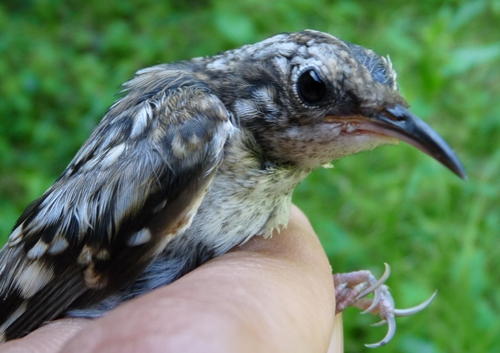 Another surprise this week in terms of timing was this Brown Creeper, also a record early date. Like the Yellow-rumped Warbler, it was still largely in juvenile plumage, suggesting that it hatched somewhere quite near MBO. (Photo by Marcel Gahbauer)
Another surprise this week in terms of timing was this Brown Creeper, also a record early date. Like the Yellow-rumped Warbler, it was still largely in juvenile plumage, suggesting that it hatched somewhere quite near MBO. (Photo by Marcel Gahbauer)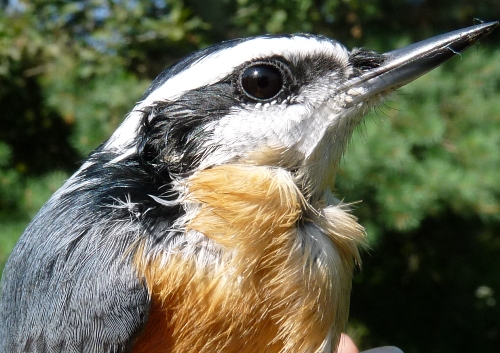 Although Red-breasted Nuthatches are reasonably common in the region, we don’t tend to see them at MBO with any regularity, and band them even more seldom. In fact, this male was only the fourth one we’ve banded, and the first since 2006! (Photo by Marcel Gahbauer)
Although Red-breasted Nuthatches are reasonably common in the region, we don’t tend to see them at MBO with any regularity, and band them even more seldom. In fact, this male was only the fourth one we’ve banded, and the first since 2006! (Photo by Marcel Gahbauer)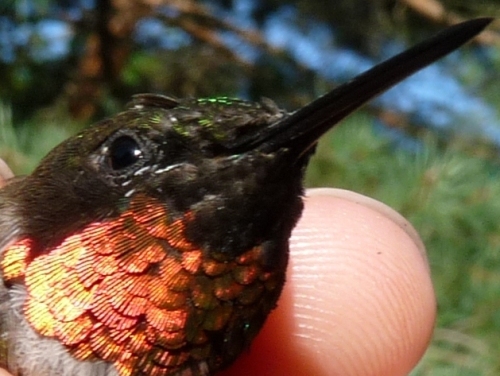 Although we aren’t banding hummingbirds, that doesn’t stop them from flying into our nets at times. At this time of year most of the Ruby-throated Hummingbirds we see are actually white-throated, so this gorgeous after-hatch-year male was a wonderful surprise.. (Photo by Marcel Gahbauer)
Although we aren’t banding hummingbirds, that doesn’t stop them from flying into our nets at times. At this time of year most of the Ruby-throated Hummingbirds we see are actually white-throated, so this gorgeous after-hatch-year male was a wonderful surprise.. (Photo by Marcel Gahbauer)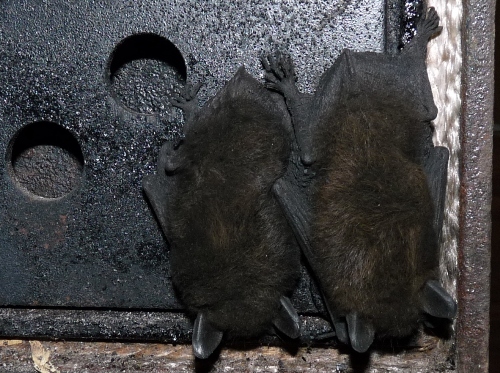 Early in the week, we heard some scratching from inside the stove pipe … and opened the door to find these two little brown bats hanging on the inside of it! We saw them three mornings in a row, then they seemed to move on to find a quieter bedroom. (Photo by Marcel Gahbauer)
Early in the week, we heard some scratching from inside the stove pipe … and opened the door to find these two little brown bats hanging on the inside of it! We saw them three mornings in a row, then they seemed to move on to find a quieter bedroom. (Photo by Marcel Gahbauer)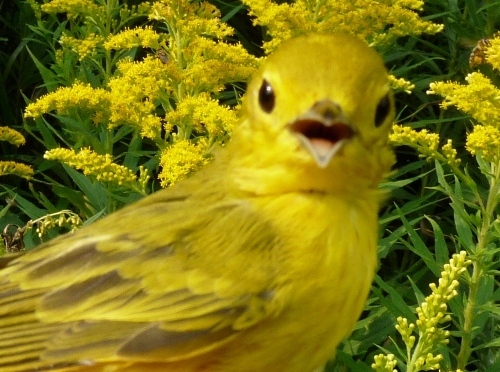 If we may be permitted a moment of anthropomorphism, it almost seems like this Yellow Warbler is speaking up in protest against being photographed with a backdrop of goldenrod, as if to say, “hey, I’m the yellow one!”. But the reality is that while goldenrod will be with us for most of the rest of fall, Yellow Warblers are one of the earliest migrants to disappear from MBO, and already toward the end of week 3 we had days without any observed, hard to believe given how dominant they remained last week. (Photo by Marcel Gahbauer)
If we may be permitted a moment of anthropomorphism, it almost seems like this Yellow Warbler is speaking up in protest against being photographed with a backdrop of goldenrod, as if to say, “hey, I’m the yellow one!”. But the reality is that while goldenrod will be with us for most of the rest of fall, Yellow Warblers are one of the earliest migrants to disappear from MBO, and already toward the end of week 3 we had days without any observed, hard to believe given how dominant they remained last week. (Photo by Marcel Gahbauer)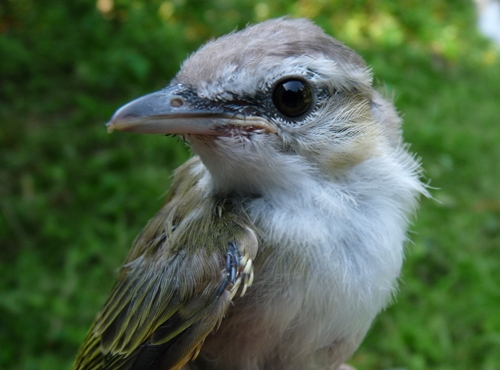 Although we’re into the third week of “fall”, there are still “babies galore”, as was noted in our daily log at one point this week. Defining the start of fall as the beginning of August is necessary to get full coverage of some of the earlier migrants, but of course many local breeders still are going strong through all of what is summer here. The latest of those are Cedar Waxwings and American Goldfinches, some of them still incubating, but the very young Red-eyed Vireo above indicates that other species were still nesting into August as well. (Photo by Marcel Gahbauer)
Although we’re into the third week of “fall”, there are still “babies galore”, as was noted in our daily log at one point this week. Defining the start of fall as the beginning of August is necessary to get full coverage of some of the earlier migrants, but of course many local breeders still are going strong through all of what is summer here. The latest of those are Cedar Waxwings and American Goldfinches, some of them still incubating, but the very young Red-eyed Vireo above indicates that other species were still nesting into August as well. (Photo by Marcel Gahbauer)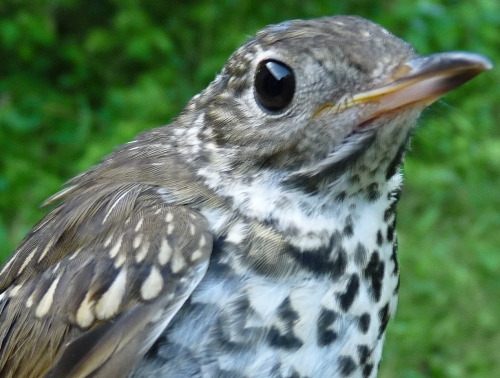 Yes, another juvenile! LIke the Brown Creeper and Yellow-rumped Warbler featured last week, this Hermit Thrush is noteworthy for showing up in our nets as a very young bird, despite us not being aware of the species nesting nearby. (Photo by Marcel Gahbauer)
Yes, another juvenile! LIke the Brown Creeper and Yellow-rumped Warbler featured last week, this Hermit Thrush is noteworthy for showing up in our nets as a very young bird, despite us not being aware of the species nesting nearby. (Photo by Marcel Gahbauer)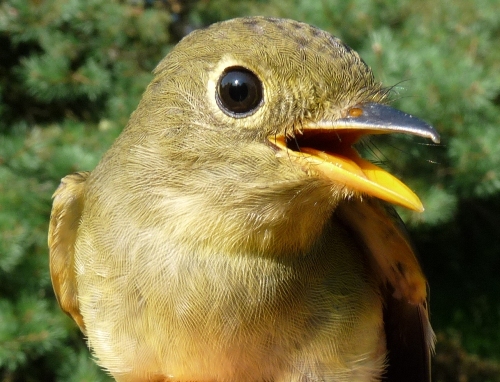 It has been said that “cuteness” can be a factor in helping distinguish among eastern Empidonax flycatchers. While Least Flycatcher is often considered to be at the top of that list, this Yellow-bellied Flycatcher is making a strong case for his/her own kind. And with Yellow-bellied Flycatcher making its first ever entry on the list of top ten species banded at MBO for the week, it’s an even more appropriate choice for our feature photo. (Photo by Marcel Gahbauer)
It has been said that “cuteness” can be a factor in helping distinguish among eastern Empidonax flycatchers. While Least Flycatcher is often considered to be at the top of that list, this Yellow-bellied Flycatcher is making a strong case for his/her own kind. And with Yellow-bellied Flycatcher making its first ever entry on the list of top ten species banded at MBO for the week, it’s an even more appropriate choice for our feature photo. (Photo by Marcel Gahbauer)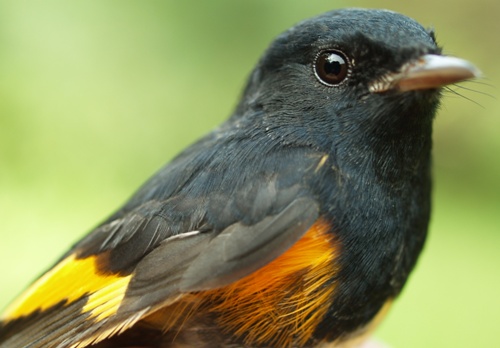 Our fascination with American Redstarts continues. This particularly striking after-hatch-year male had the darkest chest patch we’ve seen yet – “chrome orange”. (Photo by Simon Duval)
Our fascination with American Redstarts continues. This particularly striking after-hatch-year male had the darkest chest patch we’ve seen yet – “chrome orange”. (Photo by Simon Duval)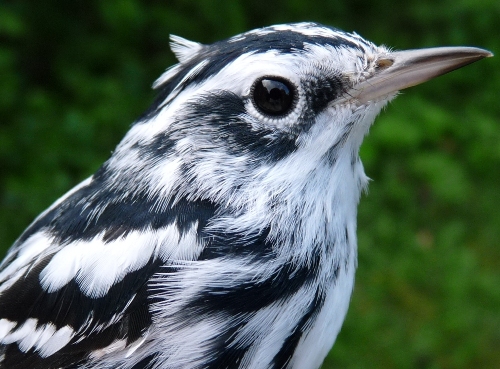 While some warblers have been relatively scarce so far this fall, the Black-and-white has actually exceeded expectations, showing up in the top half of our “top ten banded” list for two weeks in a row now. (Photo by Marcel Gahbauer)
While some warblers have been relatively scarce so far this fall, the Black-and-white has actually exceeded expectations, showing up in the top half of our “top ten banded” list for two weeks in a row now. (Photo by Marcel Gahbauer)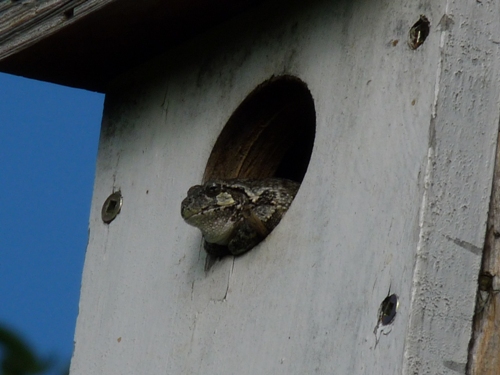 This fine fellow is a perfect example of how it pays off for volunteers to always keep searching for observations everywhere – Clémence discovered this relatively hefty-looking gray tree frog sitting in the ‘doorway’ of the bluebird/swallow nest box on our windmill, not just once, but on three separate days … and as far as we know, nobody else spotted him/her until she pointed it out! We need that sort of eagle-eyed spotting throughout the season to ensure we get good documentation of all the species less likely to be encountering any of the nets – birds and otherwise! (Photo by Marcel Gahbauer)
This fine fellow is a perfect example of how it pays off for volunteers to always keep searching for observations everywhere – Clémence discovered this relatively hefty-looking gray tree frog sitting in the ‘doorway’ of the bluebird/swallow nest box on our windmill, not just once, but on three separate days … and as far as we know, nobody else spotted him/her until she pointed it out! We need that sort of eagle-eyed spotting throughout the season to ensure we get good documentation of all the species less likely to be encountering any of the nets – birds and otherwise! (Photo by Marcel Gahbauer)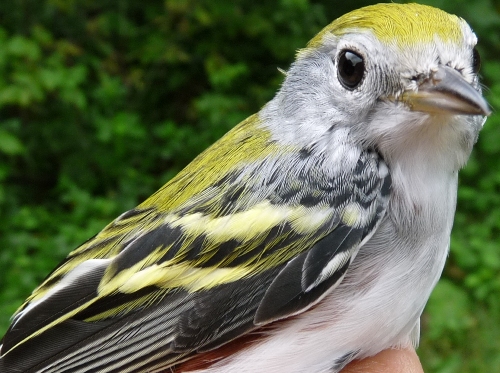 It’s not often in fall that Chestnut-sided Warblers live up to their name – but this handsome after-hatch-year male did (though even he is doing a relatively good job of concealing most of his chestnut at this time of year). (Photo by Marcel Gahbauer)
It’s not often in fall that Chestnut-sided Warblers live up to their name – but this handsome after-hatch-year male did (though even he is doing a relatively good job of concealing most of his chestnut at this time of year). (Photo by Marcel Gahbauer)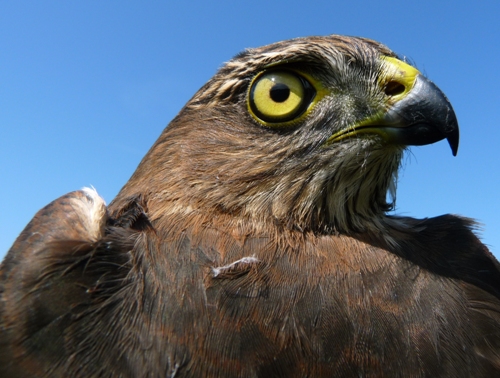 The first raptor of the season (in the nets) is always a highlight. This year it was this hatch-year female Sharp-shinned Hawk that took those honours on Tuesday morning – a bit surprising as we had been watching Cooper’s Hawks and Merlins quite near the nets that morning and in previous days, but haven’t been able to catch them yet. (Photo by Marcel Gahbauer)
The first raptor of the season (in the nets) is always a highlight. This year it was this hatch-year female Sharp-shinned Hawk that took those honours on Tuesday morning – a bit surprising as we had been watching Cooper’s Hawks and Merlins quite near the nets that morning and in previous days, but haven’t been able to catch them yet. (Photo by Marcel Gahbauer)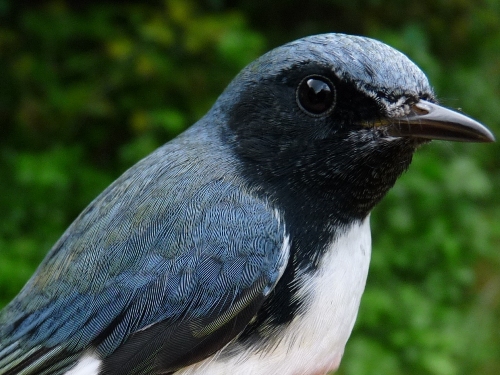 Among the warblers regularly seen at MBO, the Black-throated Blue has one of the most protracted migrations, often present from early August through to mid-October, but rarely in large numbers. So, we were pleasantly surprised to have them tied for the fourth-most frequently banded species this week, with 8 individuals in total. (Photo by Marcel Gahbauer)
Among the warblers regularly seen at MBO, the Black-throated Blue has one of the most protracted migrations, often present from early August through to mid-October, but rarely in large numbers. So, we were pleasantly surprised to have them tied for the fourth-most frequently banded species this week, with 8 individuals in total. (Photo by Marcel Gahbauer)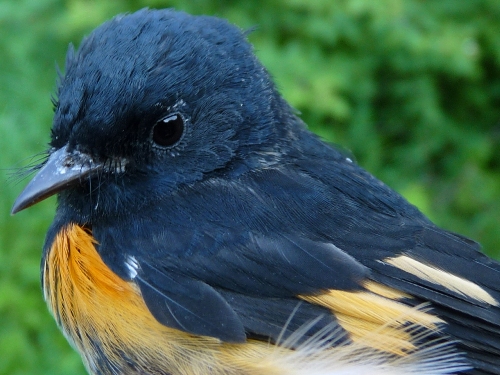 Yes, it’s yet another American Redstart photo. This, however, is a particularly interesting individual, as we banded him as an after-hatch-year male in August 2007, and this Thursday recaptured him for the first time since then. (Photo by Marcel Gahbauer)
Yes, it’s yet another American Redstart photo. This, however, is a particularly interesting individual, as we banded him as an after-hatch-year male in August 2007, and this Thursday recaptured him for the first time since then. (Photo by Marcel Gahbauer)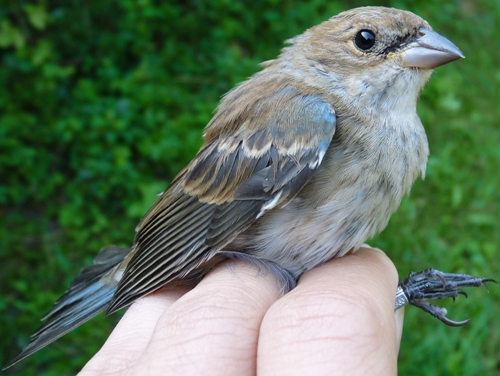 Thursday was a “blue” morning at MBO, during which we captured the Black-throated Blue Warbler featured at the top of this week’s report, plus a Blue Jay, and five Indigo Buntings, including three side by side in one net. Hatch-year birds of this species can be tricky to sex, but ones with as much blue in the shoulder and tail as this one are very likely males. (Photo by Marcel Gahbauer)
Thursday was a “blue” morning at MBO, during which we captured the Black-throated Blue Warbler featured at the top of this week’s report, plus a Blue Jay, and five Indigo Buntings, including three side by side in one net. Hatch-year birds of this species can be tricky to sex, but ones with as much blue in the shoulder and tail as this one are very likely males. (Photo by Marcel Gahbauer)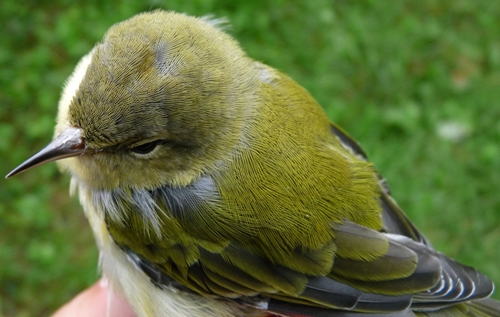 A greenish warbler with small flecks of orange on top of the head … must be an Orange-crowned Warbler, right? Wrong – this is actually an after-hatch-year Tennessee Warbler! She was banded at MBO within the first few days of the current season, and recaptured this week, i.e. roughly three weeks later. Even now, she is still replacing her flight feathers (some partly grown feathers and shafts are visible in the photo) and so probably won’t be leaving for a little while longer. The slightly orange-tipped feathers are a misleading anomaly, as otherwise the bird has relatively typical Tennessee Warbler features. (Photo by Marcel Gahbauer)
A greenish warbler with small flecks of orange on top of the head … must be an Orange-crowned Warbler, right? Wrong – this is actually an after-hatch-year Tennessee Warbler! She was banded at MBO within the first few days of the current season, and recaptured this week, i.e. roughly three weeks later. Even now, she is still replacing her flight feathers (some partly grown feathers and shafts are visible in the photo) and so probably won’t be leaving for a little while longer. The slightly orange-tipped feathers are a misleading anomaly, as otherwise the bird has relatively typical Tennessee Warbler features. (Photo by Marcel Gahbauer)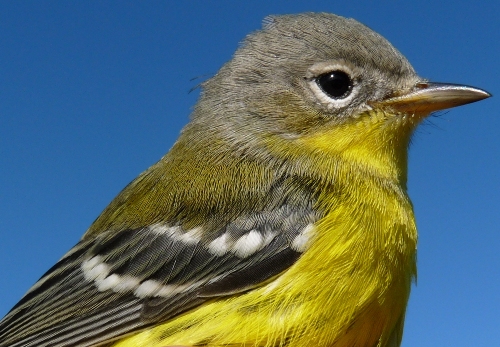 Although not as abundant as at this time last year, Magnolia Warblers were still the most abundant warbler at MBO this week. This handsome young male is further featured below with a photo of his unusually boldly marked tail. (Photo by Marcel Gahbauer)
Although not as abundant as at this time last year, Magnolia Warblers were still the most abundant warbler at MBO this week. This handsome young male is further featured below with a photo of his unusually boldly marked tail. (Photo by Marcel Gahbauer)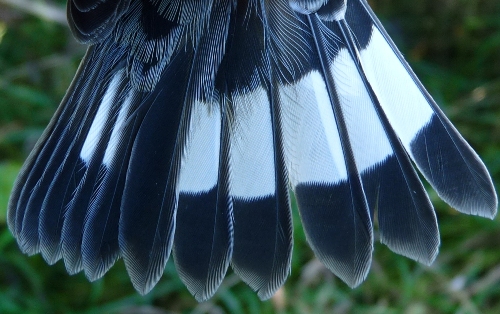 This week our supplemental research on warbler plumages transitioned from American Redstart to Magnolia Warbler. With them, we’re interested (among other things) in the extent of white on the tail. Shown above and below are two individuals that nicely illustrate the range of variation that exists. The pattern above is typically associated with after-hatch-year Magnolia Warblers, but in this case both the moult limit on the wing and the presence of an incompletely ossified skull indicated it to be hatch-year (and a male based on the extent of white, as well as being overall boldly marked).
This week our supplemental research on warbler plumages transitioned from American Redstart to Magnolia Warbler. With them, we’re interested (among other things) in the extent of white on the tail. Shown above and below are two individuals that nicely illustrate the range of variation that exists. The pattern above is typically associated with after-hatch-year Magnolia Warblers, but in this case both the moult limit on the wing and the presence of an incompletely ossified skull indicated it to be hatch-year (and a male based on the extent of white, as well as being overall boldly marked).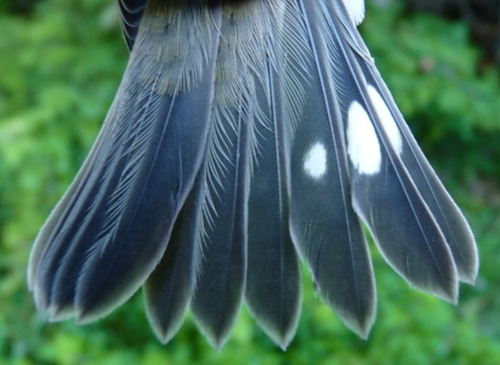
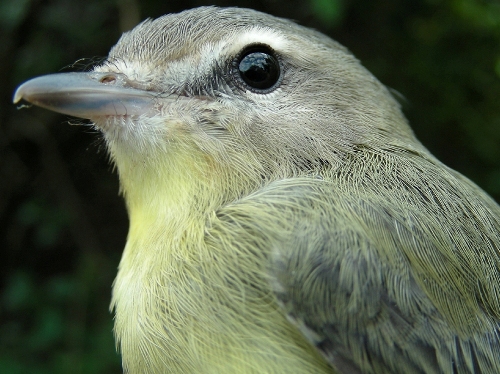 Like many other boreal-nesting songbirds, Philadelphia Vireos have been scarcer than unusual so far this fall. This one graced our nets this week, our first of the season. (Photo by Gay Gruner)
Like many other boreal-nesting songbirds, Philadelphia Vireos have been scarcer than unusual so far this fall. This one graced our nets this week, our first of the season. (Photo by Gay Gruner)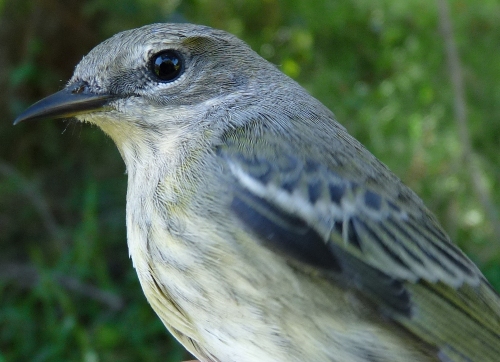 While not a particularly eye-catching bird, this hatch-year female Cape May Warbler was arguably the highlight of this week’s captures, as we’ve only banded 10 of them at MBO previously, making them our third-scarcest of the 25 warbler species we’ve caught here (only the slightly out-of-range Golden-winged and Blue-winged Warblers have a lower count). (Photo by Marcel Gahbauer)
While not a particularly eye-catching bird, this hatch-year female Cape May Warbler was arguably the highlight of this week’s captures, as we’ve only banded 10 of them at MBO previously, making them our third-scarcest of the 25 warbler species we’ve caught here (only the slightly out-of-range Golden-winged and Blue-winged Warblers have a lower count). (Photo by Marcel Gahbauer)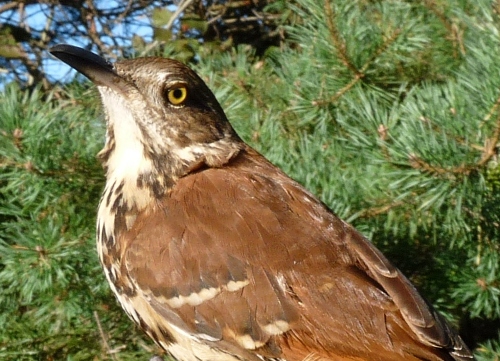 Another relatively scarce bird this week (we’ve banded an average of 6 per year) was this Brown Thrasher, which kindly showed up just in time to be seen by the entire McGill ornithology class, making their first visit to the site on Wednesday morning. (Photo by Marcel Gahbauer)
Another relatively scarce bird this week (we’ve banded an average of 6 per year) was this Brown Thrasher, which kindly showed up just in time to be seen by the entire McGill ornithology class, making their first visit to the site on Wednesday morning. (Photo by Marcel Gahbauer)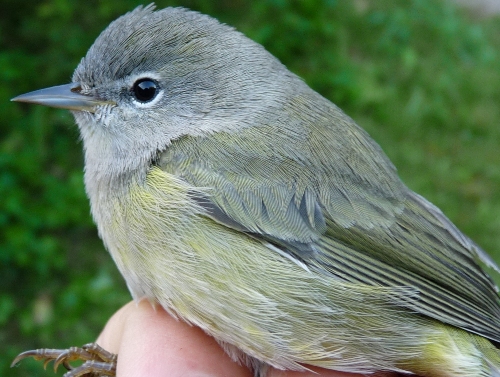 This Orange-crowned Warbler was the first of its kind banded at MBO this year. Among the least common warblers here, we band on average fewer than 10 individuals annually. This species is often mistaken for others, including Tennessee Warbler, Philadelphia Vireo, and Ruby-crowned Kinglet. However, the combination of a slender bill, yellow undertail, and grayish head is enough to identify it correctly, even when there is no orange visible on the crown, as on this hatch-year female. (Photo by Marcel Gahbauer)
This Orange-crowned Warbler was the first of its kind banded at MBO this year. Among the least common warblers here, we band on average fewer than 10 individuals annually. This species is often mistaken for others, including Tennessee Warbler, Philadelphia Vireo, and Ruby-crowned Kinglet. However, the combination of a slender bill, yellow undertail, and grayish head is enough to identify it correctly, even when there is no orange visible on the crown, as on this hatch-year female. (Photo by Marcel Gahbauer)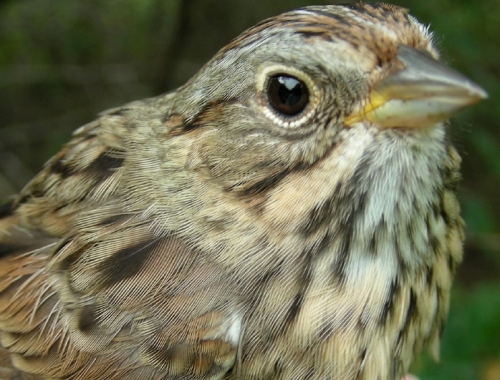 We have been enjoying an above average movement of Song Sparrows this fall, so when this elegant Lincoln’s Sparrow paid us a visit this week it immediately jumped out as something different. (Photo by Gay Gruner)
We have been enjoying an above average movement of Song Sparrows this fall, so when this elegant Lincoln’s Sparrow paid us a visit this week it immediately jumped out as something different. (Photo by Gay Gruner)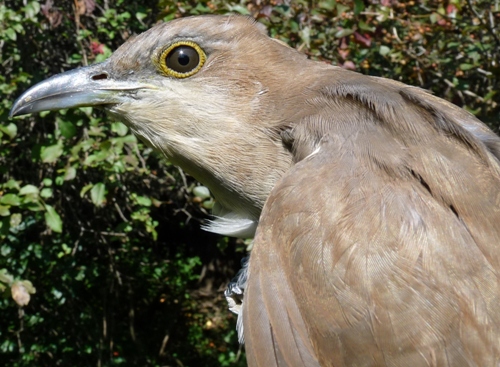 Cuckoos are always a rare treat at MBO, with only six in total banded to date. Last fall we banded two of them, but in every previous year we have caught only a single bird (a Yellow-billed in 2005, and a Black-billed in each of 2006 and 2007). The young Black-billed Cuckoo above almost escaped us – it actually did fly out of the first net it landed in, but in trying to get away flew right into a perpendicular net and was bagged before being able to make another attempt to get away. (Photos by Marcel Gahbauer)
Cuckoos are always a rare treat at MBO, with only six in total banded to date. Last fall we banded two of them, but in every previous year we have caught only a single bird (a Yellow-billed in 2005, and a Black-billed in each of 2006 and 2007). The young Black-billed Cuckoo above almost escaped us – it actually did fly out of the first net it landed in, but in trying to get away flew right into a perpendicular net and was bagged before being able to make another attempt to get away. (Photos by Marcel Gahbauer)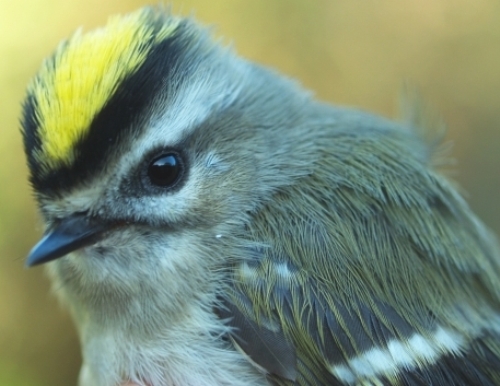 As the season advances, we continue to welcome later migrants arriving at MBO for. the first time this fall. Among them this week was this Golden-crowned Kinglet, an early individual in advance of our expected early October influx of them and their even more numerous cousins, Ruby-crowned Kinglets. (Photo by Simon Duval)
As the season advances, we continue to welcome later migrants arriving at MBO for. the first time this fall. Among them this week was this Golden-crowned Kinglet, an early individual in advance of our expected early October influx of them and their even more numerous cousins, Ruby-crowned Kinglets. (Photo by Simon Duval)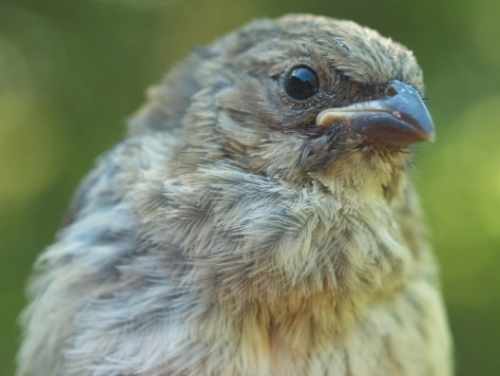 On Saturday morning we were stunned to catch this very young Indigo Bunting, still covered in juvenile plumage and with its tail only half grown! We have already banded a record number of Indigo Buntings this fall, but this is by far the youngest we’ve seen so far, despite the late date.. (Photo by Simon Duval)
On Saturday morning we were stunned to catch this very young Indigo Bunting, still covered in juvenile plumage and with its tail only half grown! We have already banded a record number of Indigo Buntings this fall, but this is by far the youngest we’ve seen so far, despite the late date.. (Photo by Simon Duval)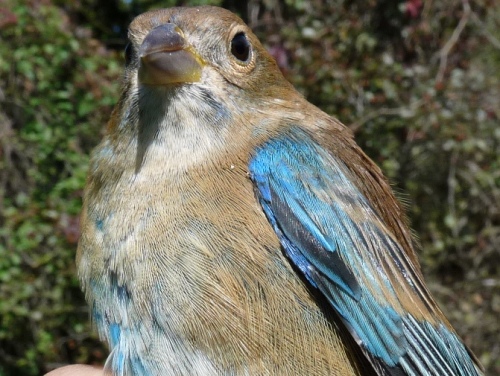 In contrast to the previous bird, this Indigo Bunting is an after-hatch-year male. It had us a bit puzzled though, as the last time we saw an after-hatch-year male it was all blue … but now it is late enough in fall for moult to have progressed to the point where they are largely brown, though strong patches of blue remain on the wings and to a lesser extent elsewhere, including scattered breast feathers. (Photo by Marcel Gahbauer)
In contrast to the previous bird, this Indigo Bunting is an after-hatch-year male. It had us a bit puzzled though, as the last time we saw an after-hatch-year male it was all blue … but now it is late enough in fall for moult to have progressed to the point where they are largely brown, though strong patches of blue remain on the wings and to a lesser extent elsewhere, including scattered breast feathers. (Photo by Marcel Gahbauer)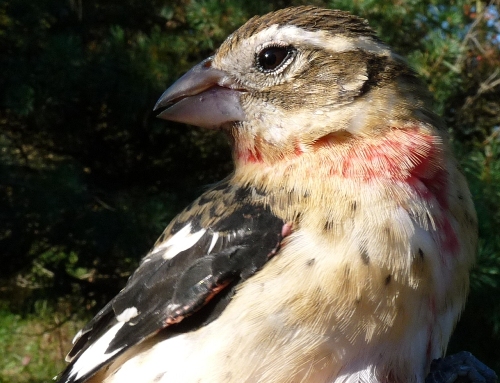 Here is another example of a plumage we rarely see. Most Rose-breasted Grosbeaks pass through MBO in August, but this male we banded this week was a special treat with respect to the extent of rose already on his breast, and the partially black wings. (Photos by Marcel Gahbauer)
Here is another example of a plumage we rarely see. Most Rose-breasted Grosbeaks pass through MBO in August, but this male we banded this week was a special treat with respect to the extent of rose already on his breast, and the partially black wings. (Photos by Marcel Gahbauer)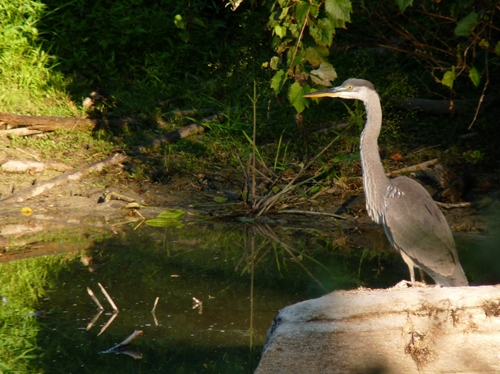 Saturday morning’s census was spectacular, with a total of 39 species being more reminiscent of spring than most fall days. Among the highlights was this Great Blue Heron fishing (well, probably frogging) in the back pond along the B/N nets. (Photo by Marcel Gahbauer)
Saturday morning’s census was spectacular, with a total of 39 species being more reminiscent of spring than most fall days. Among the highlights was this Great Blue Heron fishing (well, probably frogging) in the back pond along the B/N nets. (Photo by Marcel Gahbauer)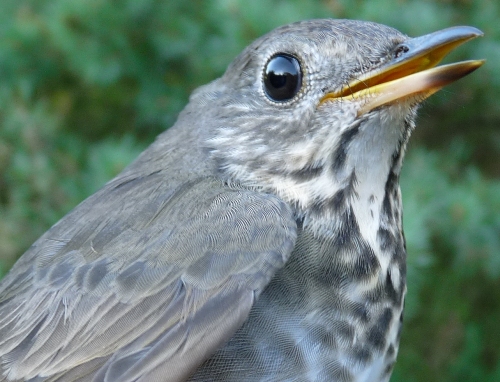 Always a rather scarce bird at MBO, Gray-cheeked Thrushes made an appearance this week with the first of the season on Sunday and another two the next morning. (Photo by Marcel Gahbauer)
Always a rather scarce bird at MBO, Gray-cheeked Thrushes made an appearance this week with the first of the season on Sunday and another two the next morning. (Photo by Marcel Gahbauer)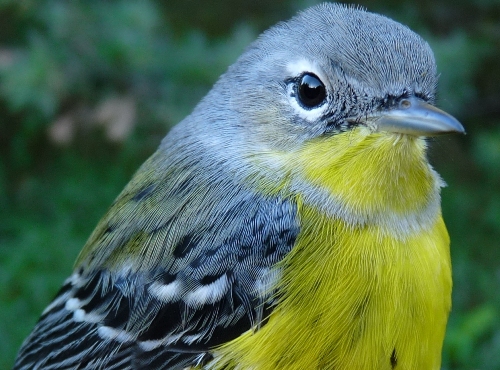 Usually the peak of Magnolia Warbler migration is a fair bit earlier in September, but we banded enough of them to put them in this week’s top three. On the whole they have been scarcer than usual this year, and most so far have been hatch-year birds, but this week we had a good number of adults, including this handsome male. (Photo by Marcel Gahbauer)
Usually the peak of Magnolia Warbler migration is a fair bit earlier in September, but we banded enough of them to put them in this week’s top three. On the whole they have been scarcer than usual this year, and most so far have been hatch-year birds, but this week we had a good number of adults, including this handsome male. (Photo by Marcel Gahbauer)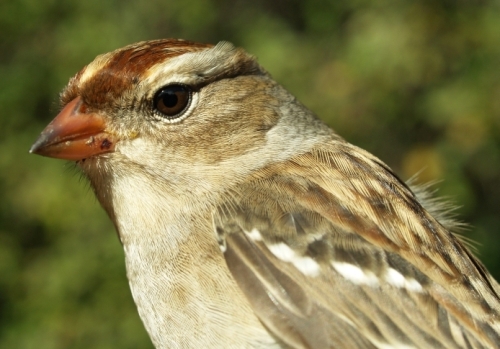 We are now solidly into sparrow season at MBO. While White-throated and Song Sparrows were (yet again) by far the most common species, White-crowned Sparrows are also becoming more numerous, with this hatch-year bird being one of 13 that we banded over the course of this week. (Photo by Simon Duval)
We are now solidly into sparrow season at MBO. While White-throated and Song Sparrows were (yet again) by far the most common species, White-crowned Sparrows are also becoming more numerous, with this hatch-year bird being one of 13 that we banded over the course of this week. (Photo by Simon Duval)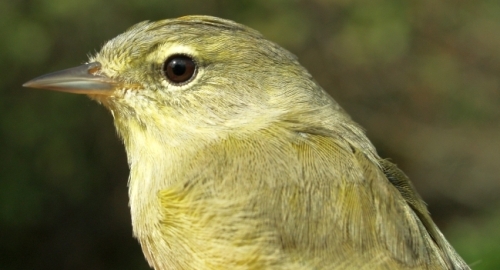 Orange-crowned Warblers are often relatively drab green and can be rather inconspicuous, but when in the hand, there’s an opportunity to inspect the crown more closely, sometimes revealing the orange feathers. (Photos by Simon Duval)
Orange-crowned Warblers are often relatively drab green and can be rather inconspicuous, but when in the hand, there’s an opportunity to inspect the crown more closely, sometimes revealing the orange feathers. (Photos by Simon Duval)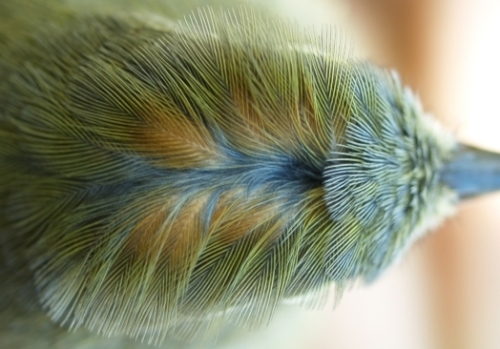
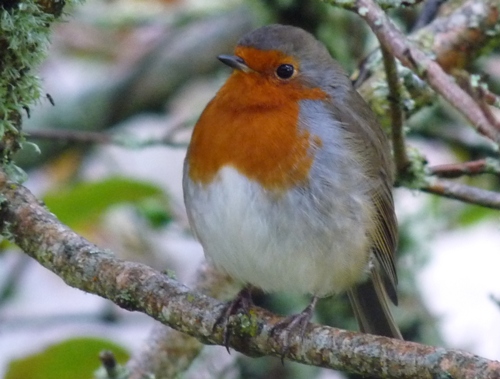 Wait a minute – what’s this? We expect that we’re on the verge of welcoming our annual October onslaught of American Robins – but if we ever spot a European Robin like this among them we’ll be quite astonished. This fine fellow graces this week’s report by virtue of MBO Coordinator Marcel Gahbauer attending a conference in Scotland this week but suffering withdrawal and dreaming about MBO at night … and at one point integrating European Robins into that storyline! Plus, it’s just too cute not to share! (Photo by Marcel Gahbauer)
Wait a minute – what’s this? We expect that we’re on the verge of welcoming our annual October onslaught of American Robins – but if we ever spot a European Robin like this among them we’ll be quite astonished. This fine fellow graces this week’s report by virtue of MBO Coordinator Marcel Gahbauer attending a conference in Scotland this week but suffering withdrawal and dreaming about MBO at night … and at one point integrating European Robins into that storyline! Plus, it’s just too cute not to share! (Photo by Marcel Gahbauer)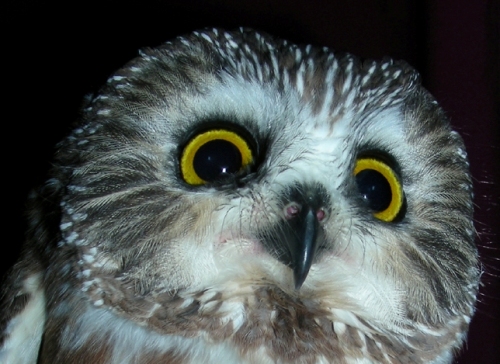 After a year off from the project, our Saw-whet banding program is back on track, with the young female above our first capture of the season, on Thursday night. (Photo by Gay Gruner)
After a year off from the project, our Saw-whet banding program is back on track, with the young female above our first capture of the season, on Thursday night. (Photo by Gay Gruner)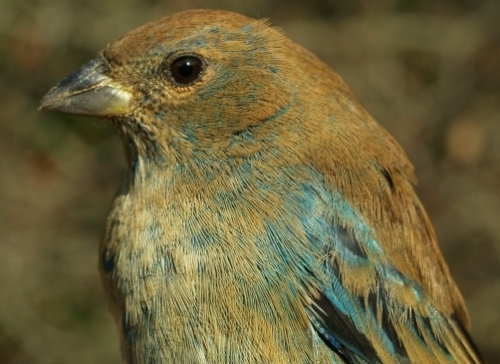 To our surprise, the Indigo Buntings just keep on coming, again banded almost daily this week. It seems like every one of the after-hatch-year birds has a somewhat different pattern of colouration. (Photo by Simon Duval)
To our surprise, the Indigo Buntings just keep on coming, again banded almost daily this week. It seems like every one of the after-hatch-year birds has a somewhat different pattern of colouration. (Photo by Simon Duval)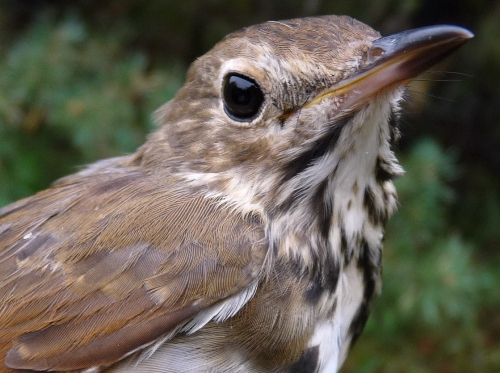 Although typically the most abundant of the Catharus species at MBO, Hermit Thrush is nonetheless a relatively uncommon migrant, with on average only around 30 individuals banded each fall … but this week we experienced a substantial invasion of them, with more banded over the past seven days than in any previous entire fall season, and as many as 16 in a single day. More remarkably still, every single one of them was a hatch-year bird! (Photo by Marcel Gahbauer)
Although typically the most abundant of the Catharus species at MBO, Hermit Thrush is nonetheless a relatively uncommon migrant, with on average only around 30 individuals banded each fall … but this week we experienced a substantial invasion of them, with more banded over the past seven days than in any previous entire fall season, and as many as 16 in a single day. More remarkably still, every single one of them was a hatch-year bird! (Photo by Marcel Gahbauer)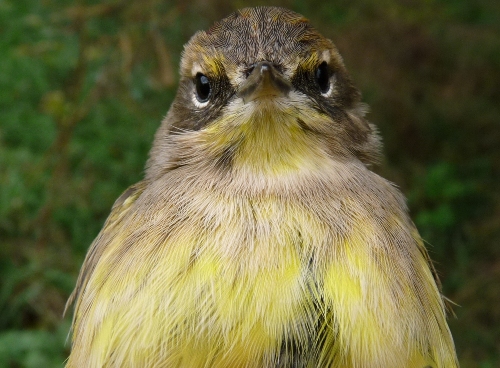 We haven’t had a lot of Palm Warblers at MBO this fall, which is disappointing as we are one of the few sites well positioned to get a good mix of the Western and Yellow races on migratoin, and we are eager to work at identifying additional features that might be useful for classifying some of the more intermediate individuals. For the one above though there was no doubt – it is definitely a Yellow Palm Warbler! (Photos by Marcel Gahbauer)
We haven’t had a lot of Palm Warblers at MBO this fall, which is disappointing as we are one of the few sites well positioned to get a good mix of the Western and Yellow races on migratoin, and we are eager to work at identifying additional features that might be useful for classifying some of the more intermediate individuals. For the one above though there was no doubt – it is definitely a Yellow Palm Warbler! (Photos by Marcel Gahbauer)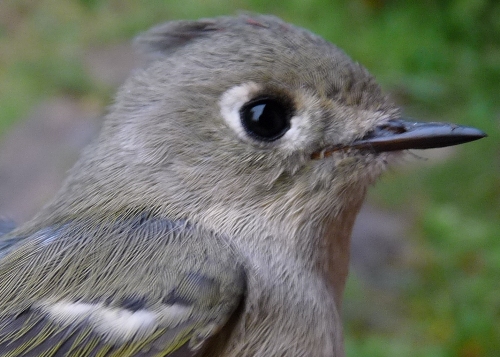 Although the abundance of Ruby-crowned Kinglets this week was not nearly as surprising as the spike in the number of Hermit Thrushes, they were still numerous enough to merit a pictorial highlight in this week’s report. (Photo by Marcel Gahbauer)
Although the abundance of Ruby-crowned Kinglets this week was not nearly as surprising as the spike in the number of Hermit Thrushes, they were still numerous enough to merit a pictorial highlight in this week’s report. (Photo by Marcel Gahbauer)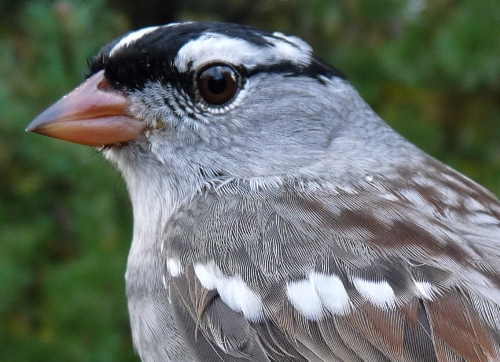 Over the course of MBO’s relatively brief history, we have seen a rather steady and substantial increase in the number of White-crowned Sparrows migrating through the site in fall. This year may well prove to be their best yet, with record highs over the past week for numbers observed and banded. Unlike many other species this fall, we’re seeing quite a few more adults (like the one above) than hatch-year individuals (like the one below). (Photos by Marcel Gahbauer)
Over the course of MBO’s relatively brief history, we have seen a rather steady and substantial increase in the number of White-crowned Sparrows migrating through the site in fall. This year may well prove to be their best yet, with record highs over the past week for numbers observed and banded. Unlike many other species this fall, we’re seeing quite a few more adults (like the one above) than hatch-year individuals (like the one below). (Photos by Marcel Gahbauer)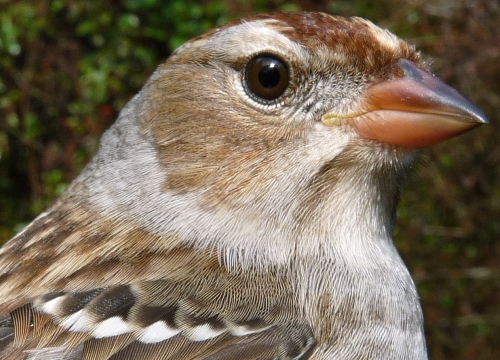
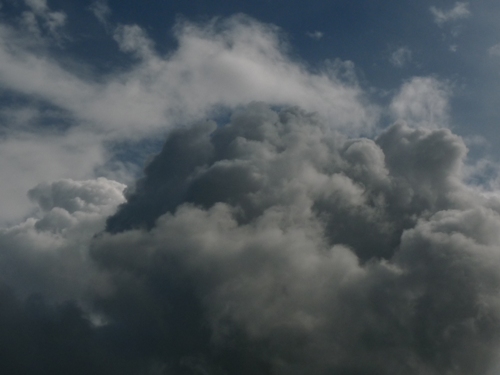 Sometimes the birds aren’t the only memorable elements of a morning at MBO. On Wednesday, the weather was truly bizarre, alternating between sun and rain on several occasions. But when this ominous cloud (above) appeared over the horizon we thought we might be in for something a bit more nasty … and sure enough, it unleashed a volley of hail (below, on our “release platform”) that lasted at least 15 minutes. Fortunately, by that time we had all the nets closed and the remaining birds being banded were kept safely inside until it was safe to release them. (Photos by Marcel Gahbauer)
Sometimes the birds aren’t the only memorable elements of a morning at MBO. On Wednesday, the weather was truly bizarre, alternating between sun and rain on several occasions. But when this ominous cloud (above) appeared over the horizon we thought we might be in for something a bit more nasty … and sure enough, it unleashed a volley of hail (below, on our “release platform”) that lasted at least 15 minutes. Fortunately, by that time we had all the nets closed and the remaining birds being banded were kept safely inside until it was safe to release them. (Photos by Marcel Gahbauer)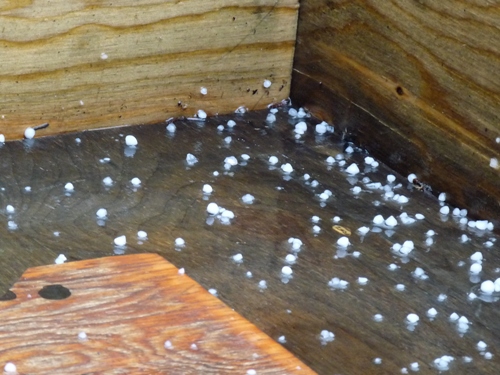
 Making up for the nasty weather outside a couple of times this week, we have taken comfort in the warmth and glow of our wood stove! (Photo by Marcel Gahbauer)
Making up for the nasty weather outside a couple of times this week, we have taken comfort in the warmth and glow of our wood stove! (Photo by Marcel Gahbauer)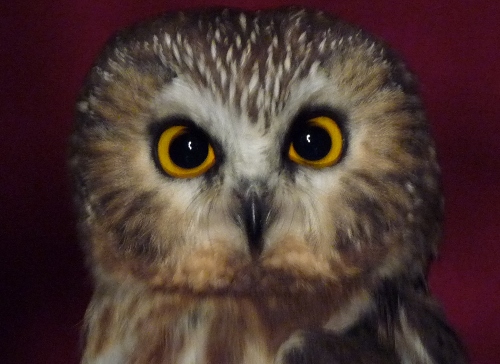 While Northern Saw-whet Owls technically aren’t part of our Fall Migration Monitoring Program, their unprecedented abundance at MBO in recent days nonetheless merits top billing in this week’s report (see below for details). The photo is a bit fuzzy since we avoid using flash photography with owls, and focus is trickier in the dark. (Photo by Marcel Gahbauer)
While Northern Saw-whet Owls technically aren’t part of our Fall Migration Monitoring Program, their unprecedented abundance at MBO in recent days nonetheless merits top billing in this week’s report (see below for details). The photo is a bit fuzzy since we avoid using flash photography with owls, and focus is trickier in the dark. (Photo by Marcel Gahbauer)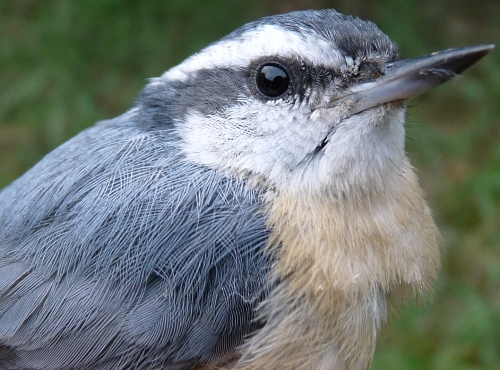 It would be an exaggeration to say we’ve been experiencing an invasion of Red-breasted Nuthatches, but given that we’ve never before banded more than one in a season (and a grand total of three before this fall), the fact that this hatch-year female was our fourth individual of the season is impressive. (Photo by Marcel Gahbauer)
It would be an exaggeration to say we’ve been experiencing an invasion of Red-breasted Nuthatches, but given that we’ve never before banded more than one in a season (and a grand total of three before this fall), the fact that this hatch-year female was our fourth individual of the season is impressive. (Photo by Marcel Gahbauer)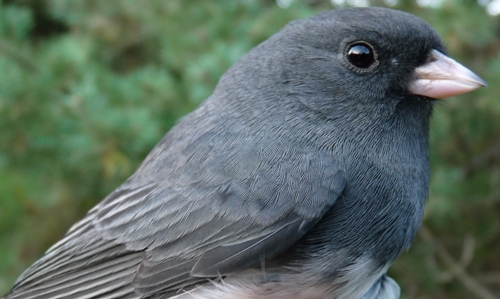 Slate-coloured Juncos are one of our dominant species in the late part of fall, and sure enough they have been among the most numerous birds at MBO this week, eclipsed in the nets only by American Robins. This after-hatch-year male shows just how dark and solid gray juncos can be, a contrast to the much more numerous hatch-year birds with their patches of brown on their wings and back. (Photos by Marcel Gahbauer)
Slate-coloured Juncos are one of our dominant species in the late part of fall, and sure enough they have been among the most numerous birds at MBO this week, eclipsed in the nets only by American Robins. This after-hatch-year male shows just how dark and solid gray juncos can be, a contrast to the much more numerous hatch-year birds with their patches of brown on their wings and back. (Photos by Marcel Gahbauer)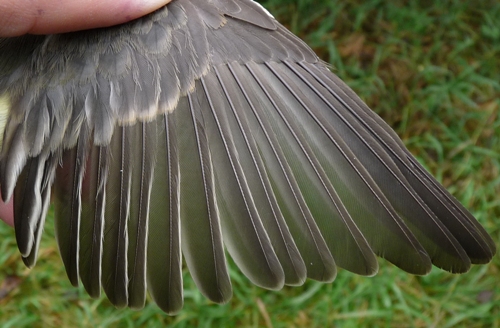 Volunteers at MBO often hear the banders talking about “molt limits”, but unfortunately some of them are rather subtle and difficult to point out. Not so with the wing of this hatch-year Eastern Phoebe! In this case there is a highly visible contrast among the greater coverts – the outermost five are retained juvenile feathers, clearly shorter than the replaced formative greater coverts closer to the body, and also more brownish, with distinct buffy tips. If only all molt limits were so easy to spot! (Photo by Marcel Gahbauer)
Volunteers at MBO often hear the banders talking about “molt limits”, but unfortunately some of them are rather subtle and difficult to point out. Not so with the wing of this hatch-year Eastern Phoebe! In this case there is a highly visible contrast among the greater coverts – the outermost five are retained juvenile feathers, clearly shorter than the replaced formative greater coverts closer to the body, and also more brownish, with distinct buffy tips. If only all molt limits were so easy to spot! (Photo by Marcel Gahbauer)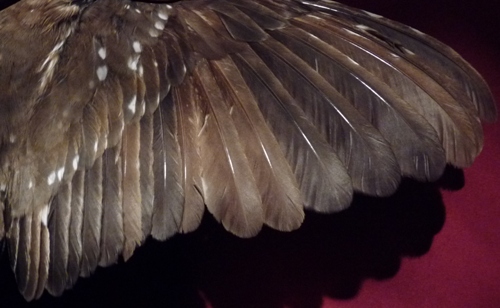 Whereas most adult passerines undergo a complete molt annually, this is not necessarily the case for other birds. For example, even though they are small, Northern Saw-whet Owls may have as many as four generations of feathers among their primaries and secondaries, recognizable by their different shades of brown (since the feathers fade and become more worn over time). In the case of the bird above, there are three distinct generations just among the primaries: the innermost two feathers (the broad feathers in the middle of the photo) are two years old, the three to the right are newly replaced from this year’s moult, the two to the right of them are one year old, and then the outermost three (not well visible) are again new. Contrast is also visible among the secondaries; of note, s1 (adjacent to the first primary) is particularly pale and frayed along the edge – it is at least two years old, and possibly three, in which case this owl would very likely be a fourth-year individual. (Photo by Marcel Gahbauer)
Whereas most adult passerines undergo a complete molt annually, this is not necessarily the case for other birds. For example, even though they are small, Northern Saw-whet Owls may have as many as four generations of feathers among their primaries and secondaries, recognizable by their different shades of brown (since the feathers fade and become more worn over time). In the case of the bird above, there are three distinct generations just among the primaries: the innermost two feathers (the broad feathers in the middle of the photo) are two years old, the three to the right are newly replaced from this year’s moult, the two to the right of them are one year old, and then the outermost three (not well visible) are again new. Contrast is also visible among the secondaries; of note, s1 (adjacent to the first primary) is particularly pale and frayed along the edge – it is at least two years old, and possibly three, in which case this owl would very likely be a fourth-year individual. (Photo by Marcel Gahbauer)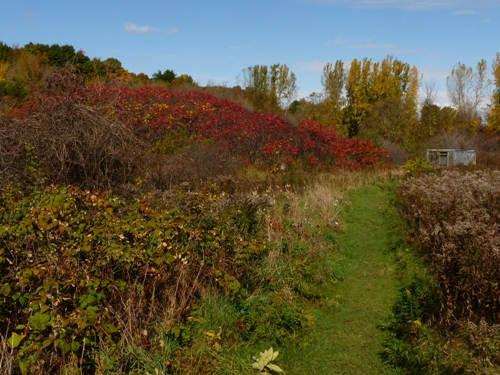 The birding may have slowed down later in week 11 due to the cold, but it was still a beautiful time to be out at MBO, with the sumac groves flaming red, the forest behind a mix of yellow and green, and some carpets of red maple leaves in the woods too. (Photos by Marcel Gahbauer)
The birding may have slowed down later in week 11 due to the cold, but it was still a beautiful time to be out at MBO, with the sumac groves flaming red, the forest behind a mix of yellow and green, and some carpets of red maple leaves in the woods too. (Photos by Marcel Gahbauer)
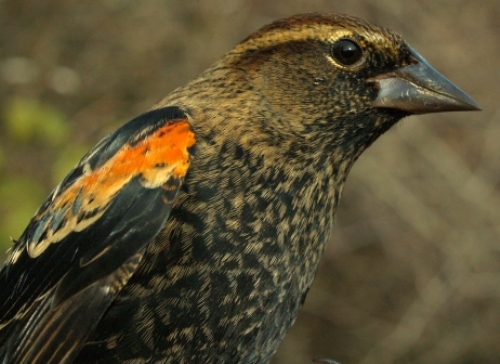 The story of this week was our unprecedented fall success with Red-winged Blackbirds – we banded 30 of them this week, more than four times as many as we’ve ever had before in a full fall season! (Photo by Simon Duval)
The story of this week was our unprecedented fall success with Red-winged Blackbirds – we banded 30 of them this week, more than four times as many as we’ve ever had before in a full fall season! (Photo by Simon Duval)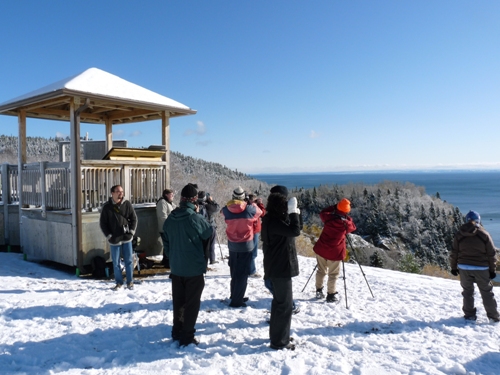 Our hosts in Tadoussac for the Canadian Migration Monitoring Network meeting were the Observatoire d’oiseaux de Tadoussac (OOT) and Explos-Nature. Above, some of the participants are scanning for migrants passing by the visual count station along the north shore of the St. Lawrence River, while below is a better view of the panorama from this point. (Photos by Marcel Gahbauer)
Our hosts in Tadoussac for the Canadian Migration Monitoring Network meeting were the Observatoire d’oiseaux de Tadoussac (OOT) and Explos-Nature. Above, some of the participants are scanning for migrants passing by the visual count station along the north shore of the St. Lawrence River, while below is a better view of the panorama from this point. (Photos by Marcel Gahbauer)
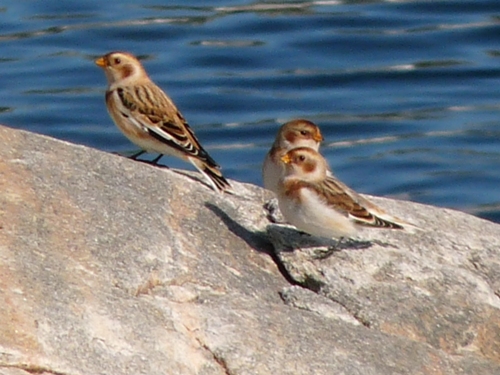 These Snow Buntings were seen in Tadoussac rather than at MBO, but we’re hopeful the first few individuals may pass by MBO during the one remaining week of fall migration monitoring, as they have in some past years. (Photo by Marcel Gahbauer)
These Snow Buntings were seen in Tadoussac rather than at MBO, but we’re hopeful the first few individuals may pass by MBO during the one remaining week of fall migration monitoring, as they have in some past years. (Photo by Marcel Gahbauer)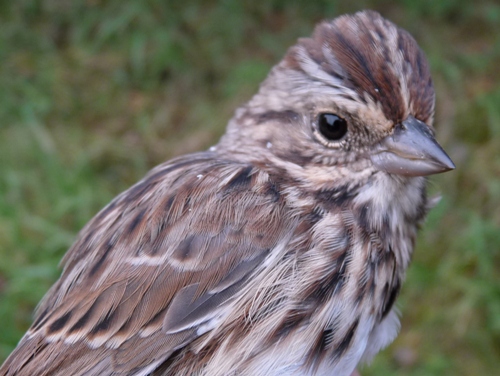 One constant throughout our long fall season has been Song Sparrows. We have banded at least 10 individuals every week this season (and as many as 50), for a grand total as of this week of 313, a single-season record for MBO. While some of them are no doubt local breeders, this high count makes it evident that MBO is also a very attractive stopover location for migrating Song Sparrows. (Photo by Marcel Gahbauer)
One constant throughout our long fall season has been Song Sparrows. We have banded at least 10 individuals every week this season (and as many as 50), for a grand total as of this week of 313, a single-season record for MBO. While some of them are no doubt local breeders, this high count makes it evident that MBO is also a very attractive stopover location for migrating Song Sparrows. (Photo by Marcel Gahbauer)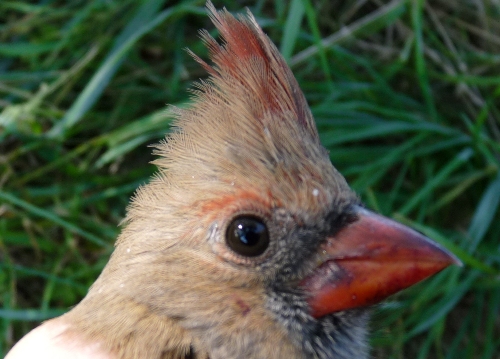 It is late enough in fall now that some hatch-year Northern Cardinals may have completed their moult. We caught this female this week, and she had just finished replacing her outermost primaries, and had uniformly adult feathers. However, the slightly dusky tone to her bill makes us wonder whether perhaps she is a hatch-year bird after all. (Photo by Marcel Gahbauer)
It is late enough in fall now that some hatch-year Northern Cardinals may have completed their moult. We caught this female this week, and she had just finished replacing her outermost primaries, and had uniformly adult feathers. However, the slightly dusky tone to her bill makes us wonder whether perhaps she is a hatch-year bird after all. (Photo by Marcel Gahbauer)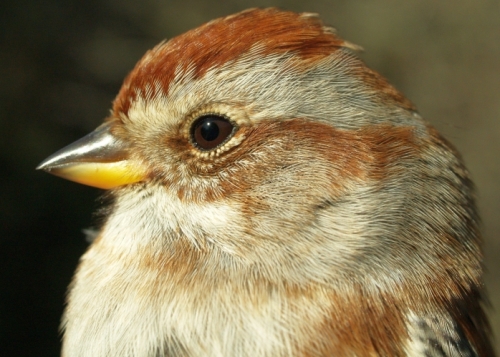 It was a great week at MBO for seeing American Tree Sparrows, as we banded far more (54) in the past seven days than in any previous full fall season (34). (Photo by Simon Duval)
It was a great week at MBO for seeing American Tree Sparrows, as we banded far more (54) in the past seven days than in any previous full fall season (34). (Photo by Simon Duval)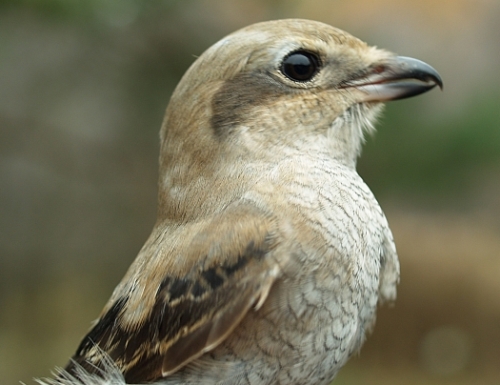 We were lucky to band two species on the final two days of the season that we hadn’t handled yet this year. Every year except 2006 we’ve banded at least one Northern Shrike near the end of the fall season, but this year we had to wait until the very last day to catch the hatch-year bird shown above. Meanwhile, the after-hatch-year male White-breasted Nuthatch below is only the 5th of its kind ever banded at MBO, and the first since fall 2006! (Photos by Simon Duval)
We were lucky to band two species on the final two days of the season that we hadn’t handled yet this year. Every year except 2006 we’ve banded at least one Northern Shrike near the end of the fall season, but this year we had to wait until the very last day to catch the hatch-year bird shown above. Meanwhile, the after-hatch-year male White-breasted Nuthatch below is only the 5th of its kind ever banded at MBO, and the first since fall 2006! (Photos by Simon Duval)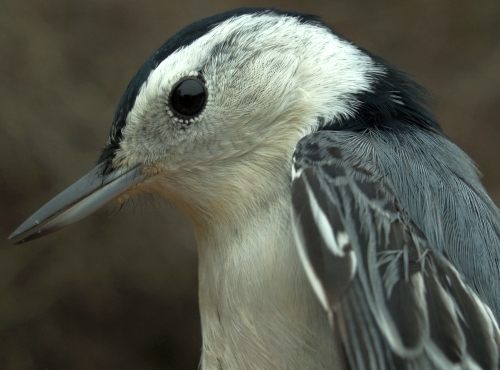
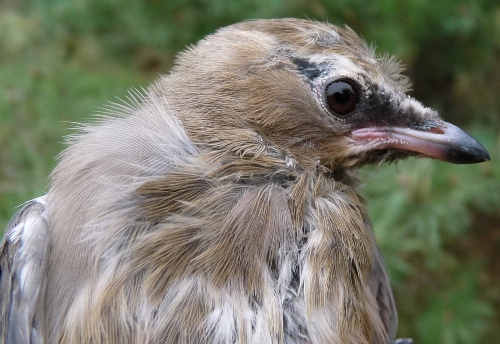 These two birds are at opposite ends of the age spectrum. The juvenile Cedar Waxwing above looks like it has been out of the nest for only a couple of weeks – hard to believe given that we banded it in the final week of October, but it seems a few birds nested unusually late this year. In contrast, the Black-capped Chickadee below is an old friend, banded during our 2004 fall pilot season, and frequently encountered ever since. Also of note this week was a Blue Jay we banded in 2005 and had not recaptured again until this week. (Photos by Marcel Gahbauer)
These two birds are at opposite ends of the age spectrum. The juvenile Cedar Waxwing above looks like it has been out of the nest for only a couple of weeks – hard to believe given that we banded it in the final week of October, but it seems a few birds nested unusually late this year. In contrast, the Black-capped Chickadee below is an old friend, banded during our 2004 fall pilot season, and frequently encountered ever since. Also of note this week was a Blue Jay we banded in 2005 and had not recaptured again until this week. (Photos by Marcel Gahbauer)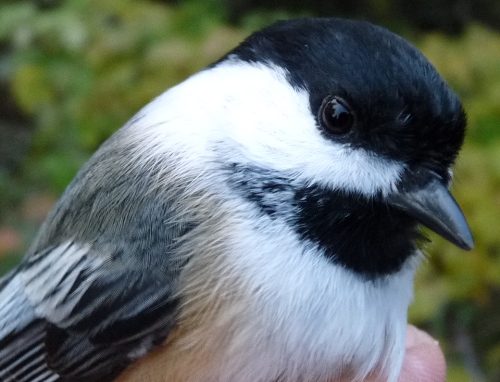
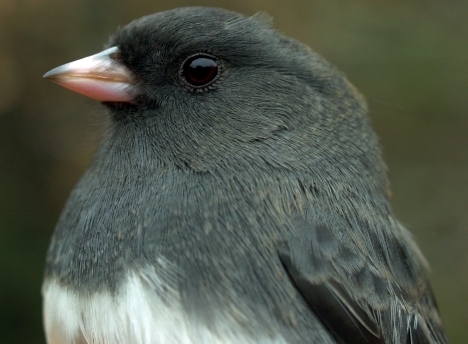 Juncos dominated the nets during our final week of fall, accounting for half of all birds banded. In the process, we witnessed quite a variety of plumages – not only good examples of all age/sex classes, but also a couple of oddities. The bird above was our final bird banded of the 2009 fall season, a handsome after-hatch-year male. (Photo by Simon Duval)
Juncos dominated the nets during our final week of fall, accounting for half of all birds banded. In the process, we witnessed quite a variety of plumages – not only good examples of all age/sex classes, but also a couple of oddities. The bird above was our final bird banded of the 2009 fall season, a handsome after-hatch-year male. (Photo by Simon Duval)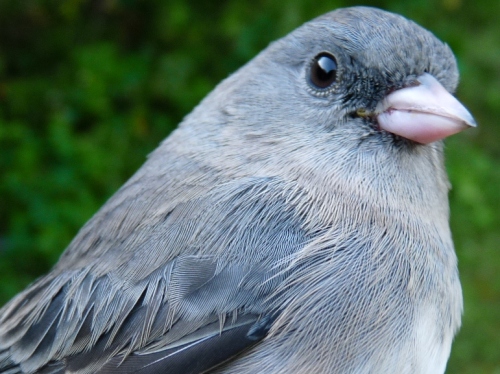 At the opposite extreme from the male in the first photo, this hatch-year female is very pale, with a considerable brown wash to her plumage both front and back. (Photo by Marcel Gahbauer)
At the opposite extreme from the male in the first photo, this hatch-year female is very pale, with a considerable brown wash to her plumage both front and back. (Photo by Marcel Gahbauer)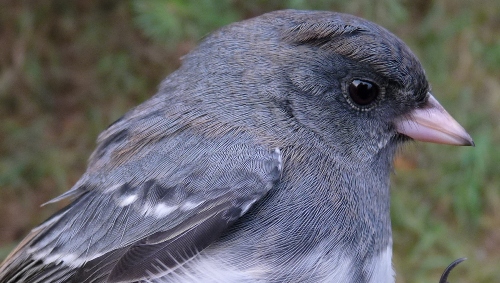 Two of the male juncos this week had distinct white tips on their greater and median coverts. Although there is a western race known as White-winged Junco, it wouldn’t be expected this far east, and in any case is considerably larger than the eastern Slate-coloured Junco. Perhaps though there are some western genes in the ancestry of these birds? (Photo by Marcel Gahbauer)
Two of the male juncos this week had distinct white tips on their greater and median coverts. Although there is a western race known as White-winged Junco, it wouldn’t be expected this far east, and in any case is considerably larger than the eastern Slate-coloured Junco. Perhaps though there are some western genes in the ancestry of these birds? (Photo by Marcel Gahbauer)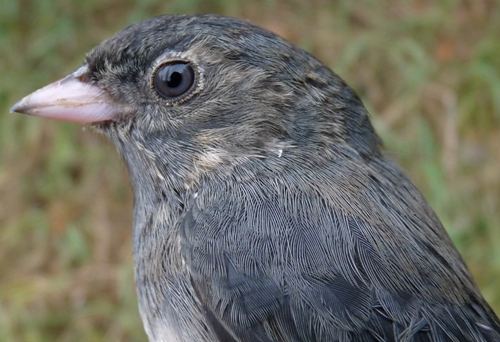 Sometimes we see individuals that just don’t match any of our usual expectations for a species. This particular junco had a scruffy look, with pale patches around the head, including a bit of an eye-ring, highlighting the very gray iris. (Photo by Marcel Gahbauer)
Sometimes we see individuals that just don’t match any of our usual expectations for a species. This particular junco had a scruffy look, with pale patches around the head, including a bit of an eye-ring, highlighting the very gray iris. (Photo by Marcel Gahbauer)